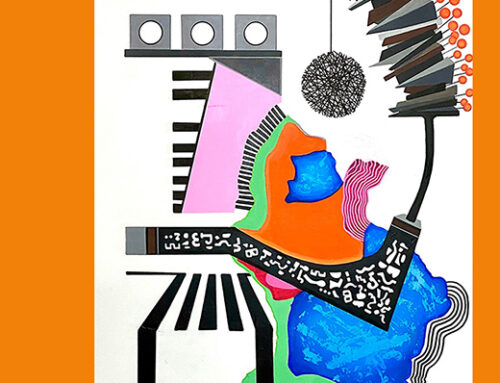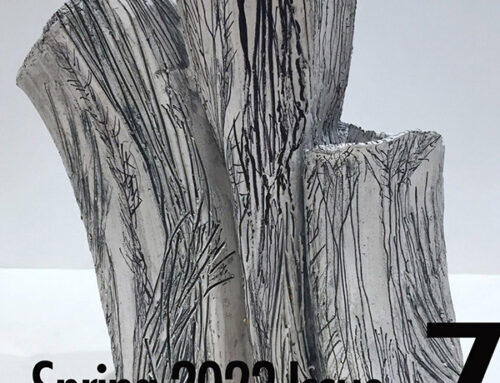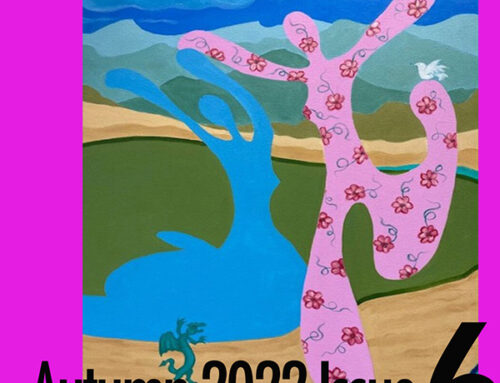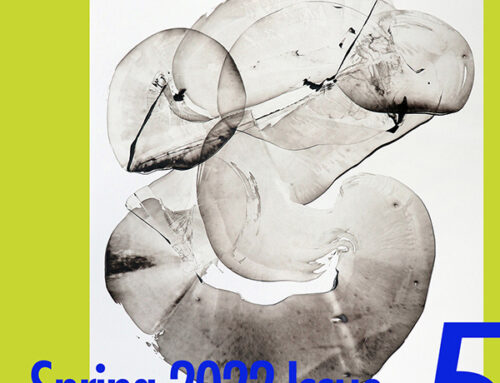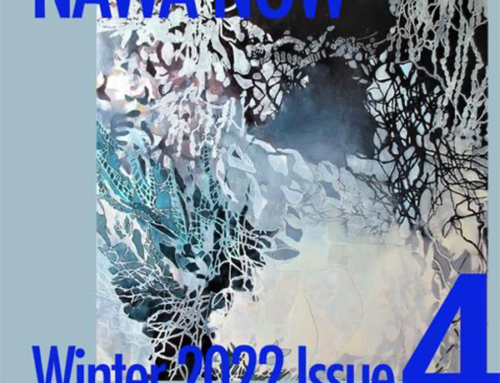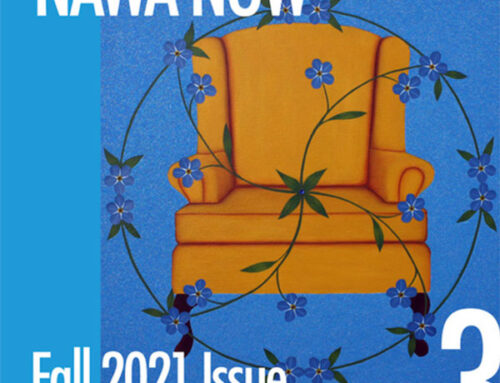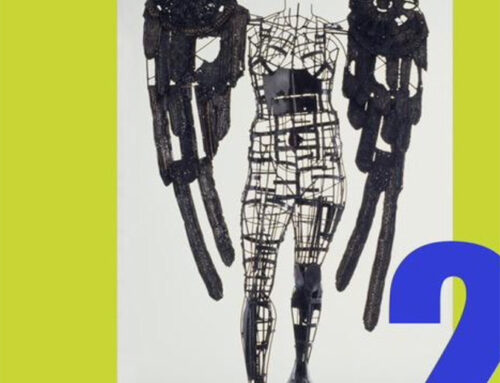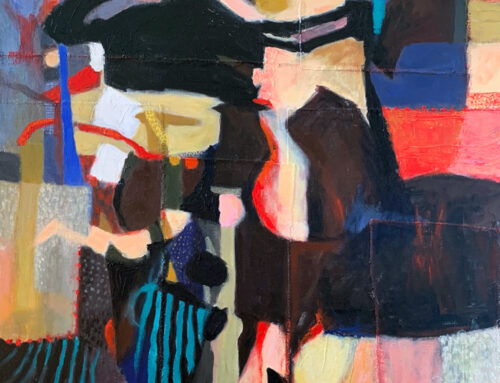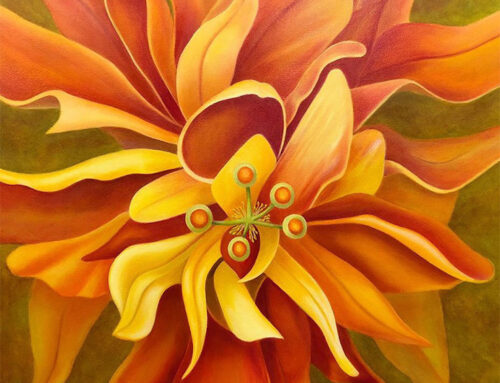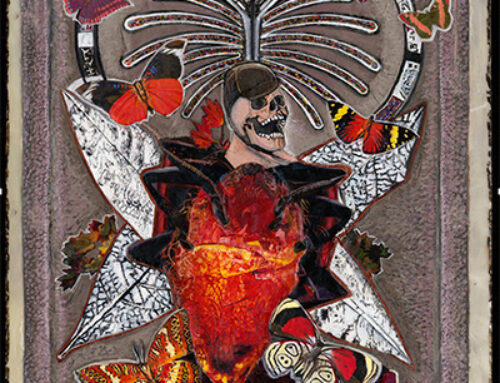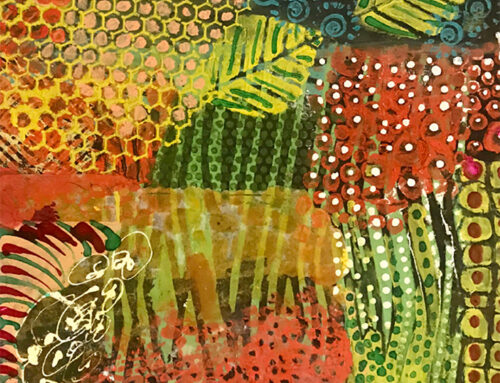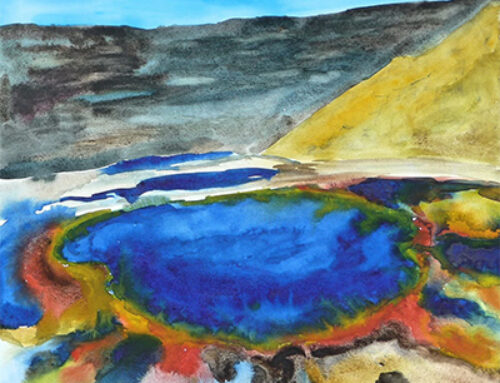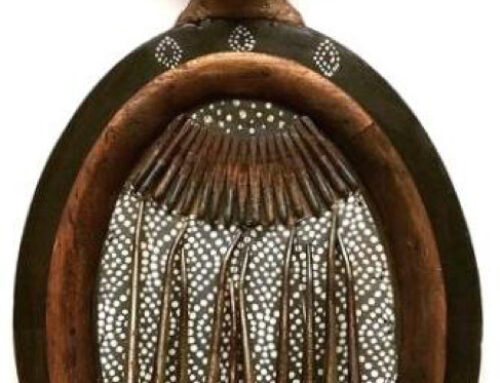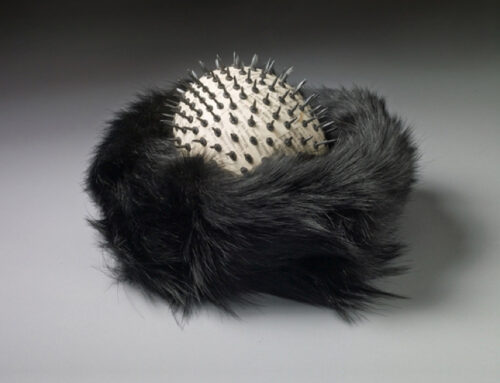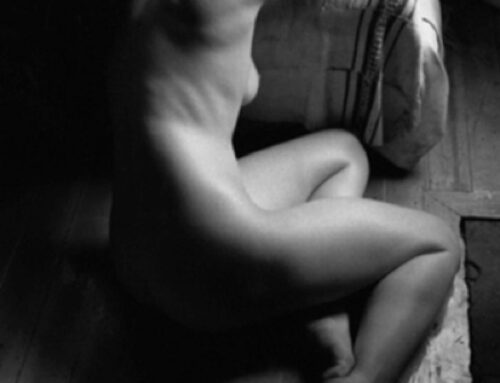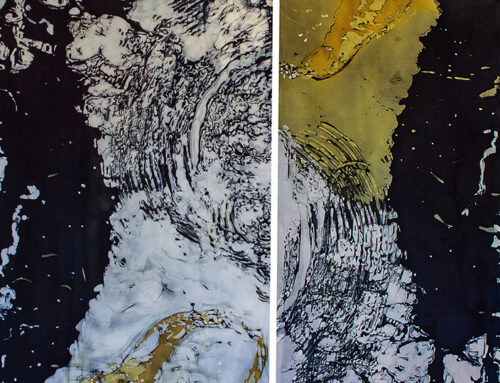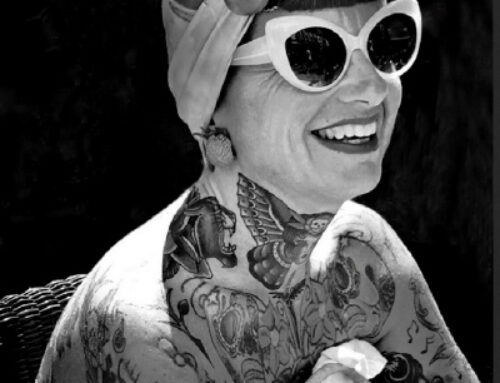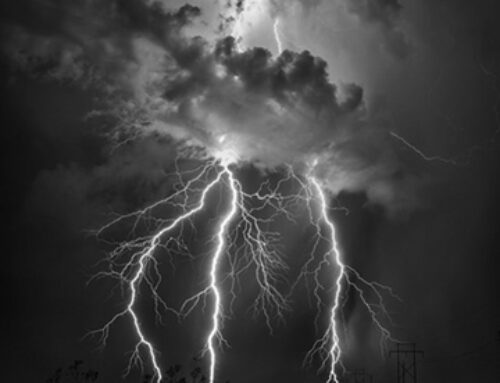
January 2020
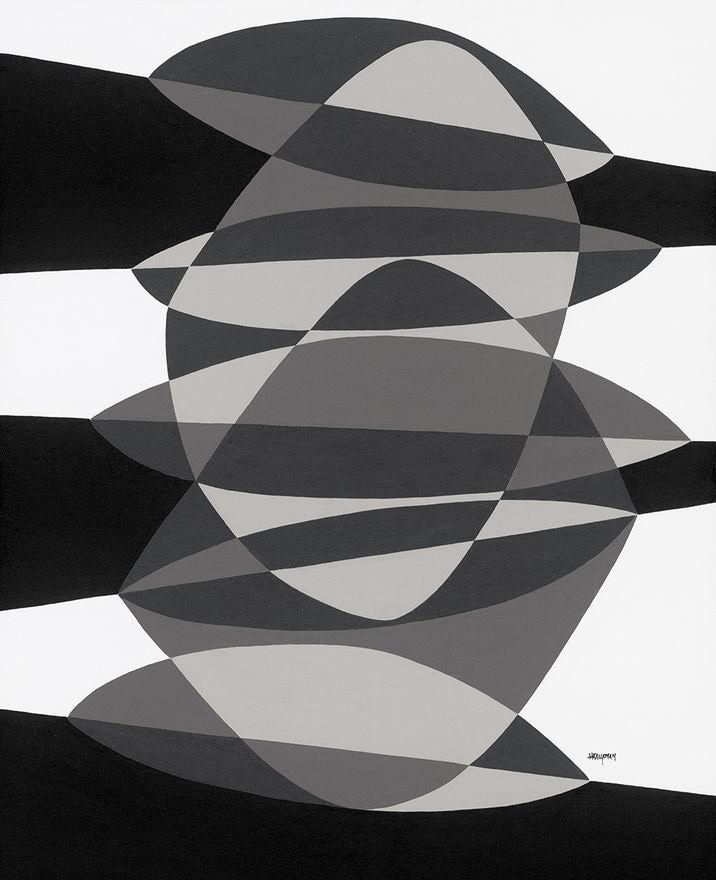
Loretta Kaufman, GMO, GM, Oh-Oh II, Environment Series, 30 H x 2 W in, © 2017
ABOUT GMO, GM-Oh-Oh
By Loretta Kaufman
GMO, GM-Oh-Oh II. Are these ears of corn? Are they fish? Or something else? Are they foreign genes from bacteria, viruses, insects or animals extracted and artificially forced into genes of an unrelated plant or animal? The big questions are: Are GMO’s safe, are there risks, and what could go wrong? Evaluation of potential environmental benefits is still in its infancy. There are many unknowns about the effects of this practice in humans. All this inspired the GMO, GO-Oh-Oh: Environment Series. The process is to paint similar flat forms with a limited palette using acrylic on canvas. The forms are united and interconnected.
PRESIDENT’S CORNER
Happy New Year!
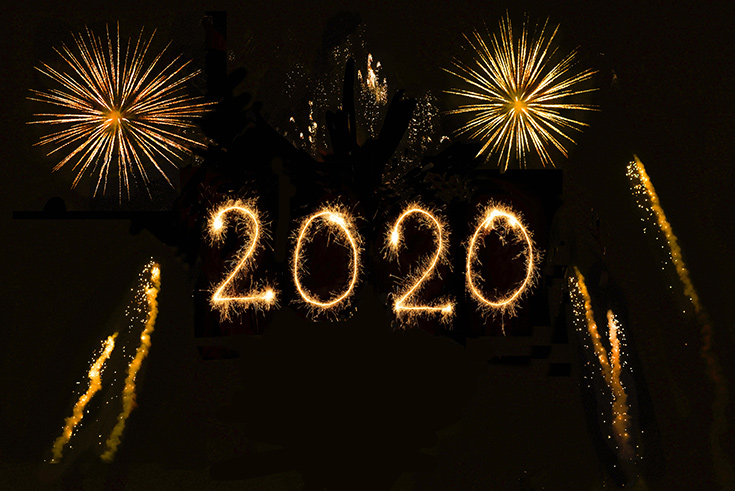
Our 2020 vision is to move forward with terrific exhibitions planned and community outreach educational workshops while increasingly expanding NAWA’s online presence.
Our amazing Susan G. Hammond has stepped up to an Emerita status, and we welcome new Executive Director Biana Kovic. (See interview with her in this issue.)
The NAWA end of the year fundraising campaign was a great success, thanks to the outstanding efforts of NAWA Board member Dana Albarella James and her associates.
I encourage all NAWA members to share the word about NAWA on Instagram, inviting more women artists, art critics and collectors to become aware of our organization. Please use #nawa_news and #thenawa.
To a productive, creative, successful year!
Natalia Koren Kropf
President, NAWA
NAWA SHOUT OUTS
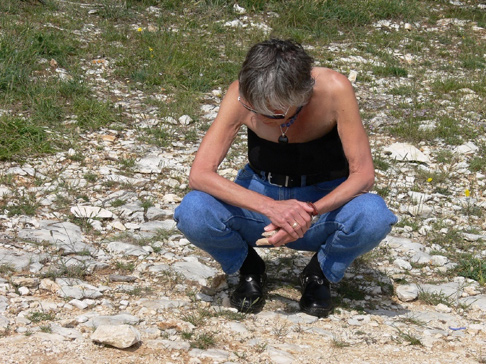 LORETTA ANA KAUFMAN
LORETTA ANA KAUFMAN
Nature and the natural world have always been the center of Loretta Kaufman’s work and are the sparks that start the process. In nearly five decades, Nashville sculptor and painter Loretta Kaufman has worked with wood, fiber, metal, clay and paint.
Originally from New York, raised in Venezuela, Loretta has lived and worked in the Bahamas and South Africa. She graduated from Palm Beach State College, studied at the Art Institute of Ft. Lauderdale and with noted ceramic artist Mohaczy-Matic in Pretoria. Loretta has completed numerous residencies in the South Carolina Arts Commission Arts in Education Program, taught sculpture at the Greenville County Museum of Art School and was a Visiting Artist at the University of South Carolina.
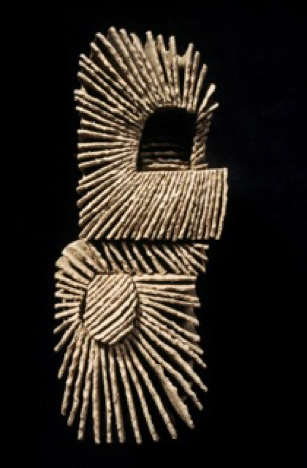
Loretta Ana Kaufman, Double Monologues I: The Celia Series, Hand built stoneware, 15 x 15 x 5 in.
Loretta’s work has been published and reviewed in many journals. In 2018, her oil painting was published in the book of poetry “Gate Posts with No Gate – The Leg Paint Project” which carries an endorsement from Sean Hemingway. Some awards are First Place in the Monarch Ceramic Competition (US, Canada, Mexico) for her clay wall relief in 1988; the Cecile Adler Cliffer Memorial Cutting Edge Award (open to all media) for her acrylic painting in the 129th Annual National Association of Women Artists (NAWA) Members’ Exhibition at Chrystie Street Gallery in 2018; and her clay free standing sculpture received an Honorable Mention in NAWA’s 2019 exhibition Sculpture On & Off the Wall. In 2017 Loretta was presented with the Albert Nelson Marquis Who’s Who Lifetime Achievement Award. Her sculpture has been exhibited worldwide, most recently at INDEX Dubai 2018, Dubai World Trade Center UAE.
The Tennessee Arts Commission has planned a retrospective of Loretta’s sculpture, paintings, mixed media pieces, and works on paper from February 7 to April 3, 2020 in Nashville. Her work is in permanent collections in Washington, DC, New York, NY, Johannesburg, South Africa and London, England among others. Private collections are numerous both here and abroad. Loretta’s full biography is listed in Who’s Who In The South & Southwest, Who’s Who In American Art, and Who’s Who In America.
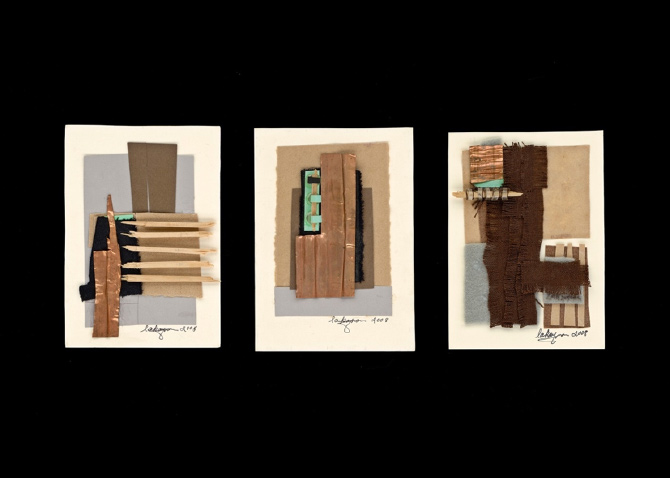
Loretta Ana Kaufman, Copper Series
Mixed media: Copper, wood, fiber, sandpaper, 20 x 25 in.
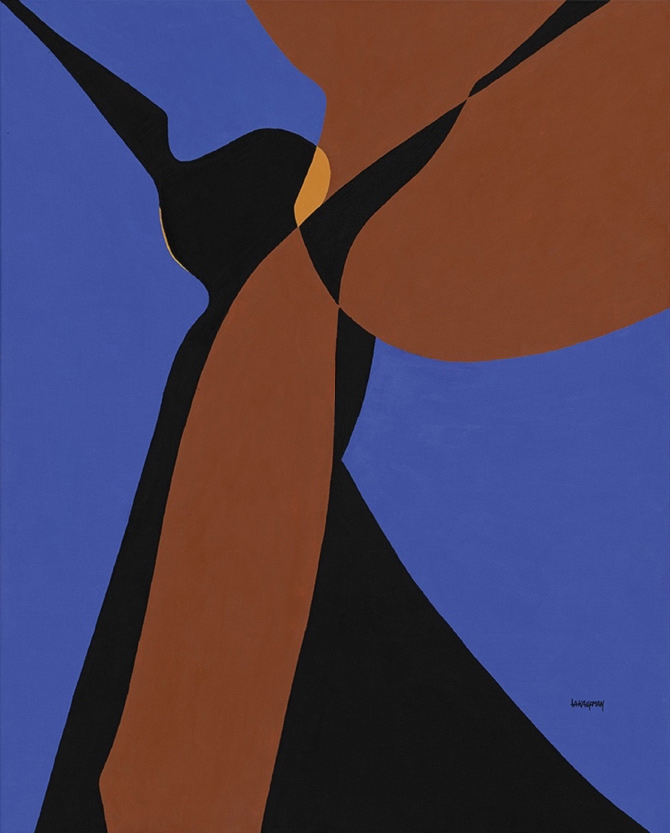
Loretta Ana Kaufman, Wedge Series, Acrylic on canvas, 30 x 24 in.
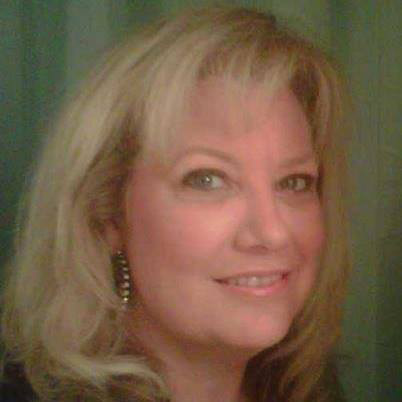
KATE KENNEDY
Kate is the current board president of the South Carolina chapter of NAWA. As an artist, she brings a most interesting and varied background to the organization. Kate has been painting since she could hold a brush. She began classical fine art studies in painting and drawing at University in eighth grade, graduating from Gonzaga University in 1983 with a B.A. in Fine Art.
She spends most of the year in Charleston, SC and summers in the Pacific Northwest. Kate loves to be near the water, and her choice of studio locations always includes a view of a lake, river, or ocean. She is known for her ability to entice viewers into the visual experience she creates via unique compositions, a masterful use of color, light, and the occasional “giggle” ingredient.
Kate’s favorite medium is oil paint. She starts with a translucent under painting of ink or oil paint washes, adding layers of oil glazes to bring out subtle color changes. Her combination of direct, reflected and translucent light creates powerful results. ”My dream world connects to the physical world, and a mysterious force takes my brush to a place where all things are possible.”

Kate Kennedy, Emergence, Oil on canvas, 32 x 40 in.
She has always been inspired to express appreciation and gratitude for life through nature’s physical beauty, primarily water. Her art is an exploration of fantasy, reality, memory, and the endless possibilities of how it all intersects in the world around us. Her influences are broad— from the classic masters such as Michelangelo and his inspired projects, Georgia O’Keeffe and her oversized flower imagery, to Frits Thaulow, Norwegian impressionist who inspired her rhythmic, fluid, brush strokes.
Kate’s work is in numerous private and corporate collections, around the world.
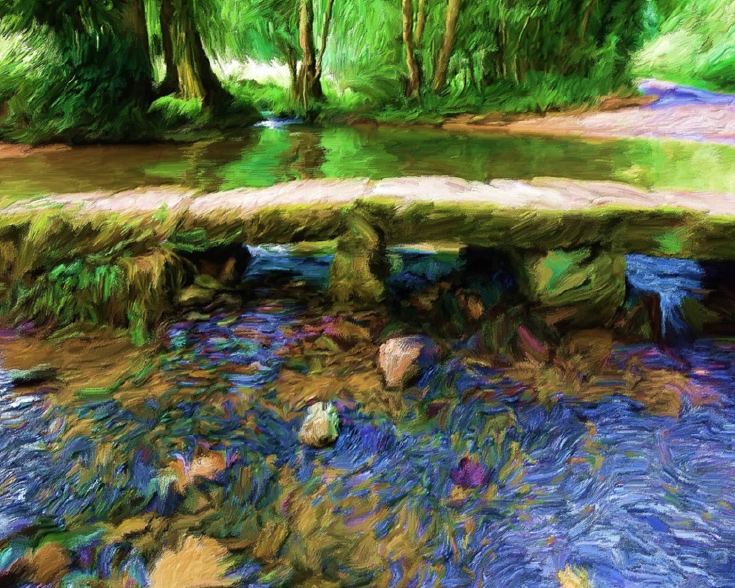
Kate Kennedy, Water’s Edge, Oil on canvas, 32 x 40 in.
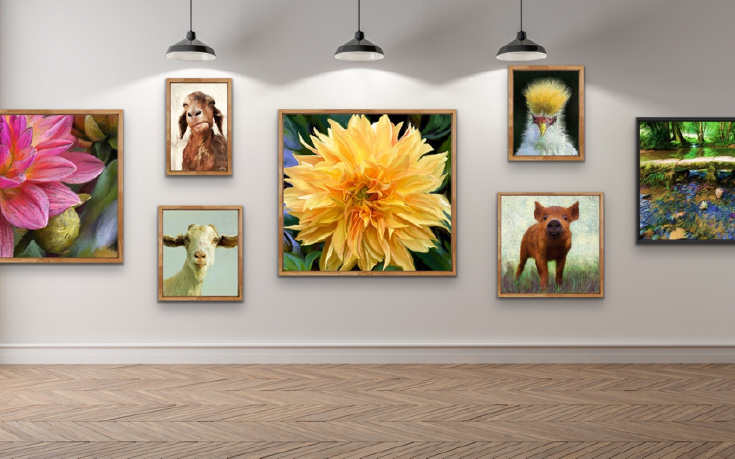
Kate Kennedy, The Art Critics, Marker 23 Gallery, Stuart, Florida.

Carol P Kunstadt in her studio.
CAROLE KUNSTADT
Carole P. Kunstadt has been featured in NAWA NOW before, but she is one artist that never ceases to inspire us with her timeless works.
In 1973 she received a BFA, magna cum laude, from Hartford Art School, W. Hartford, CT and continued with postgraduate studies at Akademie der Bildenen Künste, Munich, Germany. As a collagist, painter, book arts and fiber artist, she often invokes a metaphysical quality of contemplation and timelessness. By deconstructing paper and text, recent works reference the material of books, music manuscripts, and ephemera, often combined with artifacts.
Carole is honored to be the recipient of many awards, including the Yasuo Kuniyoshi Award 2017, Woodstock Artists Association and Museum, Woodstock, NY (WAAM); Medal of Honor & Anna Walinska Memorial Award 2017, National Association of Women Artists; Award for Excellence 2016, and Edward Hopper House Museum & Study Center, Nyack, NY. Her show, PRESSING ON, also ran at WAAM in 2018, where she was selected as one of eight yearly solo exhibitions, juried by Gallery Owner Kenise Barnes. Her current WAAM exhibition Artistic Legacy: 1 + 1 + 1 presents work of an historic Woodstock artist, the work of that artist’s descendant and the work of a contemporary artist selected by the descendant.
Her work has appeared in many solo and group exhibitions as well as in publications such as ArtsWestchester’s 2018 Inaugural Triennial showcase. Public Collections include among others the George J. Mitchell Department of Special Collections & Archives, Bowdoin College Library, Brunswick, ME; The Book Arts Collection, National Museum of Women in the Arts, Washington, DC; and The Permanent Collection of The Center for Book Arts, NY, NY.
Of note: The Everhart Museum of Natural History, Science & Art, Scranton, PA showcased a selection of her Sacred Poems in Between the Covers: Altered Books in Contemporary Art. The Museum of Biblical Art, New York, NY featured the complete Old Testament Series in the exhibition As Subject and Object: Contemporary Book Artists Explore Sacred Hebrew Texts. Representative works from the Old Testament Series were featured in And The Word Is…. in the Gershman Gallery at the University of the Arts, Philadelphia, PA and were included in Somewhere Between Creation and Destruction, Joseloff Gallery, Hartford Art School, Hartford, CT.
The PBS/OFF BOOK Book Arts mini-documentary in the series on progressive arts, features Kunstadt in the segment, Transforming the Sacred.
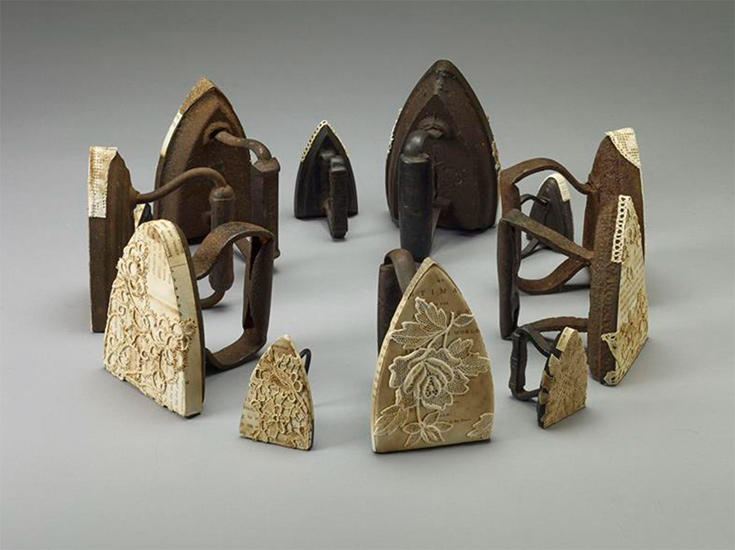
PRESSING ON – HOMAGE TO HANNAH MORE, NO. 25, NO. 10, NO. 12, NO. 44, NO. 16,5.5 × 4 × 4.5 in. – 3.5 x 2.25 x 2.5 in. (front, left to right) – antique sad irons, scorched antique lace and paper: pages from An Estimate of the Religion of the Fashionable World, By One of the Laity, London, 1791, Hannah More
PRESSING ON
by Carole P. Kunstadt
164 pages, with 78 color plates
6″ × 8″
Printed in the USA on Mohawk Superfine paper
Binding: smyth sewn
Cover & spine: foil stamped.
Edition of 100
2019
Available online, via the Too Many Photos in the World Store.
SAUNDRA RENEE SMITH
Saundra Renee Smith is a native of St. Helena Island, SC, and is proud to be a new member of NAWA’s national organization as well as a member of the South Carolina chapter. She is authentically Gullah as a direct descendent of the Guale and African descendants of the isolated island off the southeast coast of SC. She is a self-taught, outsider folk artist who grew up living near the famous folk artist, Sam Doyle. Renee’s work has been recognized by local publications, magazines, advertisers, and television. Her work is permanently installed at the entrance of the Brook Green Garden’s Gullah Geechee Garden in Myrtle Beach SC.
She has been celebrated at historical Penn Center’s York W. Bailey Museum on St. Helena as Artist of the Year. Renee’s work can be found in the famous low country gallery, The Red Piano II Gallery on St. Helena Island, SC. She is listed among recognized self-taught, outsider folk artists of America in Sellen’s Guide to American Artists.

Saundra Renee Smith, Acrylic on canvas, Waitin, 12 x 36 in.
Renee’s work is inspirational with lively reflections of her memories of growing up “Gullah” on the salt marshes of her sea island home. In her words, she was “surrounded and nurtured by strong Gullah women with brightly colored dresses blowing in the soft breeze and hats pulled down low to conceal secrets of the spirits and magic of my sea island home.” She is very proud to be among the recognized artists of the Gullah/Geechee Historical Cultural Corridor.
She credits husband Michael as one of the guiding lights that helped her to discover the hidden artist inside when she needed inspiration, teaching herself to paint through difficult times into a new world of color and hope. Since then, her work has traveled the country and internationally as far as Ireland, Spain, and England. Her unique colorful fans have quickly become collectors’ items with her original art work. Find Gullah Art By Renee at https://gullahartbyrenee.com/.
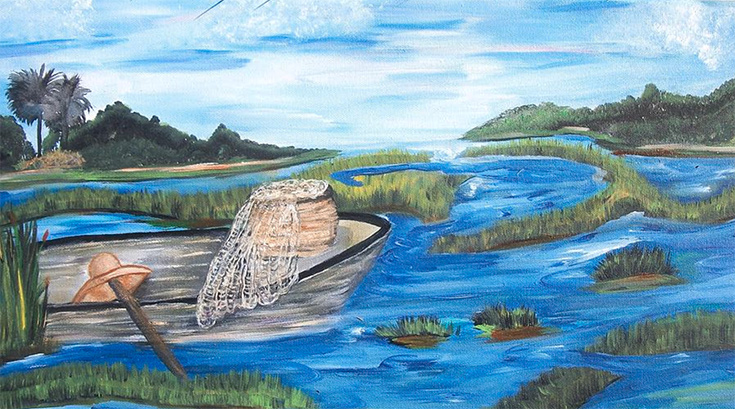
Saundra Renee Smith, Tide Comin En, Acrylic on canvas,12 x 36 in.

Saundra Renee Smith, Flowers Fa De Walk Home, Acrylic on canvas, 8 x 10 in.
 RHONDA URDANG
RHONDA URDANG
Rhonda Urdang is an independent studio artist working across multiple disciplines.
She has been making and exhibiting her artwork since 1971. Since founding Flagstaff Feminist Art Project, she has worked primarily in femmage, book art, collage, digital manipulation, painting and satire. Her thought-provoking pieces have been shown extensively in regional, national and international shows in 39 states. Her collage, Liberation of Harriet Tubman (1867) received a Medal of Honor in NAWA’s 130th Annual Exhibition in 2019.
Rhonda received her BFA in painting from the University of Nebraska at Omaha and worked as a journeyman color separation artist on high-fashion catalogs in the graphic arts industry in Omaha and Phoenix. Her visionary artwork responds to historical and world events. Human, civil, and worker’s rights have been important social issues for her.
She gains visual pleasure from unraveling the feminine mystique while peeling away layers of buried eidetic memory in her art practice. She has been reviving and reimagining neoclassical portraiture. Most recently, her artwork Séance with Peggy Guggenheim will be part of 31 Women Artists at the Sedona Arts Center, January 3-January 26, 2020. This exhibit is a recreation of Peggy Guggenheim’s 31 Women Artists Exhibition of 1943, curated by Dr. Catherine McAra, University Curator at Leeds Art University, UK.
Rhonda has lived in Northern Arizona for three decades. Her work is informed by the people, places, and color palette of her surroundings. Currently, she is writing her memoirs.
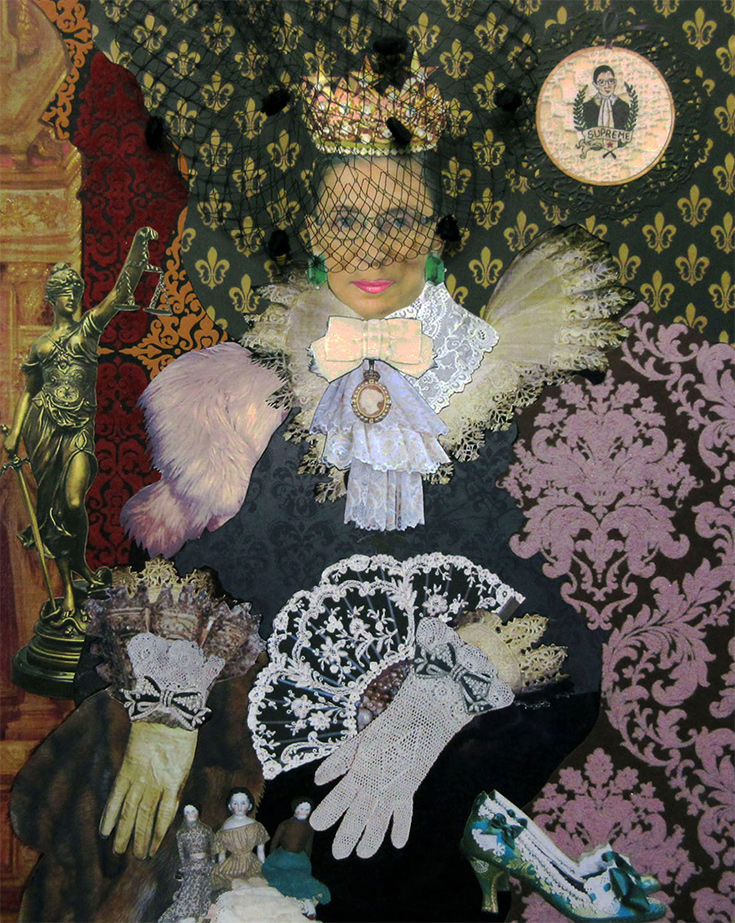
Rhonda Urdang, I Dissent: Lipstick Justice RBG, 2018, Work on paper.
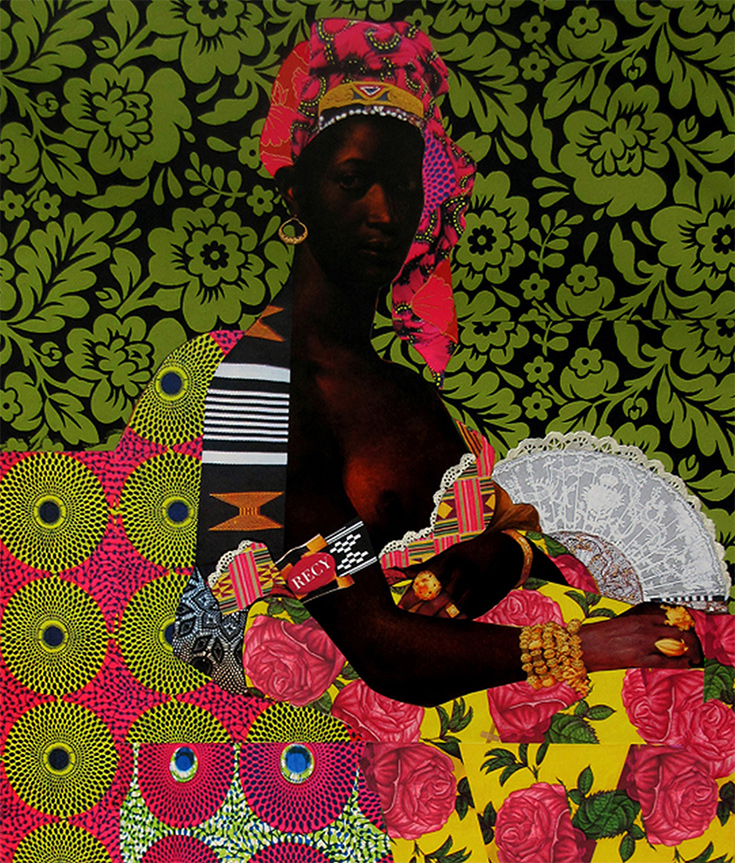
Rhonda Urdang, After Portrait of a Negress (1800), Work on paper.
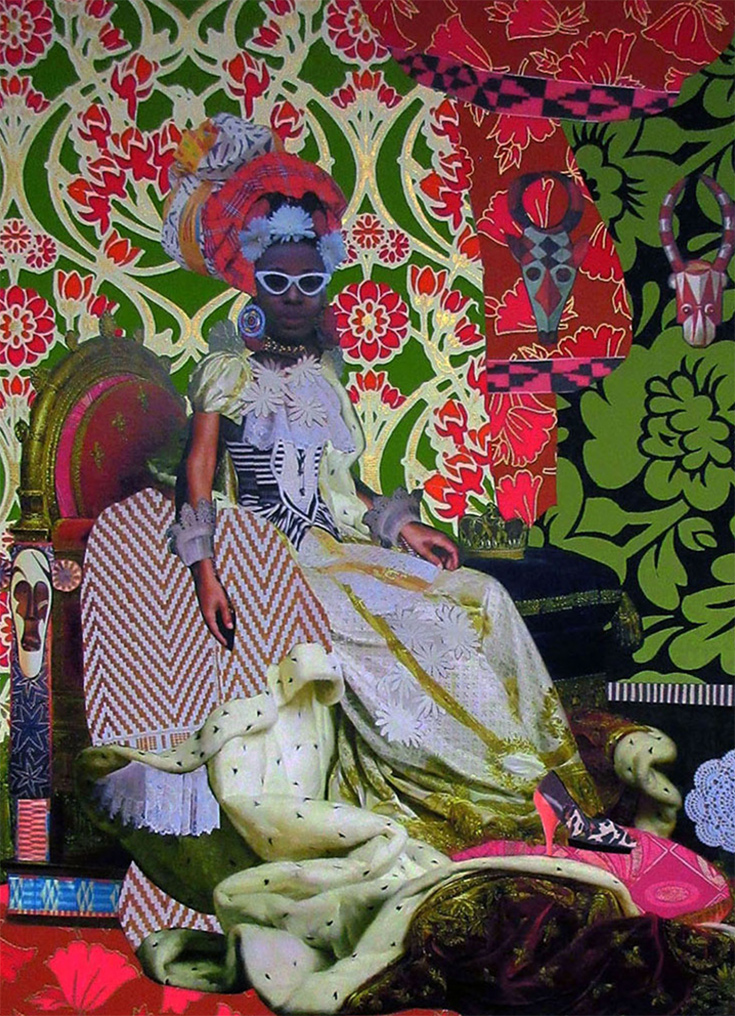
Rhonda Urdang, After Empress Josephine (1804), Work on paper.
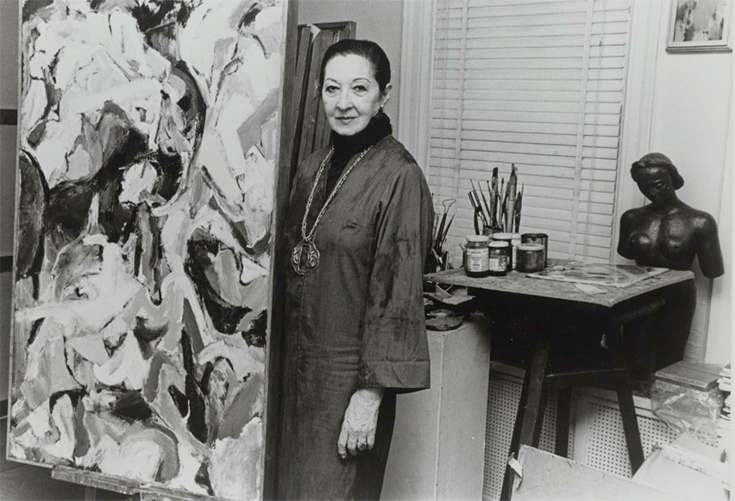
Anna Walinska in her studio, preparing for her last lifetime retrospective at the Cathedral of St. John the Divine, New York City, 1979.
ANNA WALINSKA
We have featured the life and artworks of Anna Walinska in a former issue of NAWA NOW. She remains in our memories as a strong NAWA supporter and outstanding artist.
Sixty-five years ago, Anna Walinska arrived at the most significant stop of her six-month journey around the world. She had come to visit family (her brother was serving as economic adviser to Burmese Prime Minister U Nu), and would eventually document her explorations throughout the country, along with stories about dignitaries, journalists and other artists. Her diaries are now preserved in the collected Anna Walinska papers at the Smithsonian Archives of American Art.
It was in Burma that Walinska discovered the handmade Shan paper she used in her work for years after returning home, showcased in a 1961 exhibition titled The Collage & The Figure at the Monede Gallery on Madison Avenue. Throughout the journey, she continued her palette knife paintings on paper, which she first began as a student in Paris in the twenties, at a time when she could not afford canvas or sometimes even paper and painted small abstracts on postcards.
Works influenced by this trip are currently on exhibition in New York City. Anna Walinska: Return to the Riverside at The Master Gallery, 310 Riverside Drive, former home of The Riverside Museum. The exhibition runs through January 24, 2020.
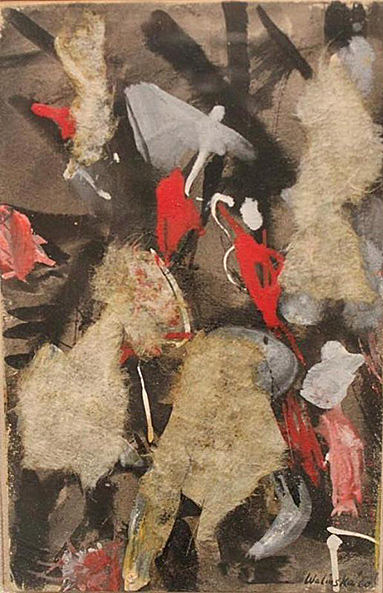
Anna Walinska, Figures in Landscape, c.1960, Shan paper collage with oil on paper
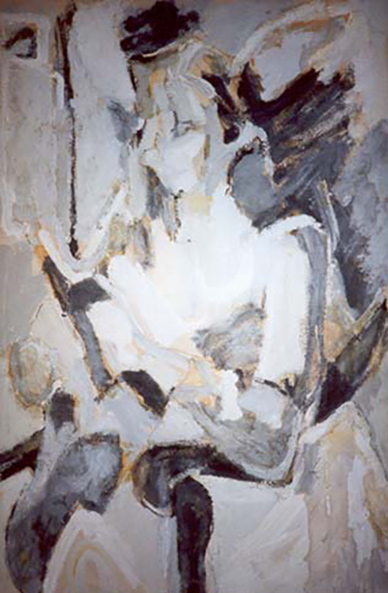
Anna Walinska, Portrait of Emily, Casein on board, c. 1961
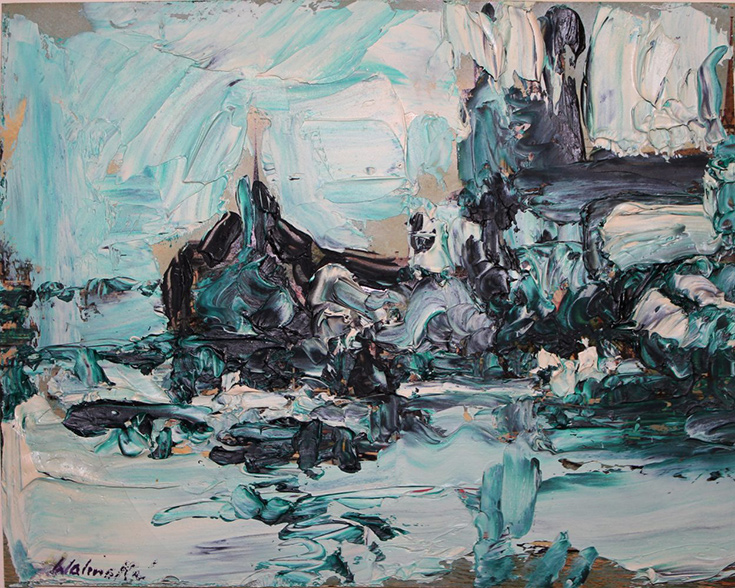
Anna Walinska, Riverscape,Oil with palette knife on paper, c.1955
RED CARPET – EXECUTIVE DIRECTOR
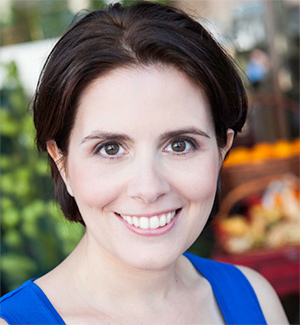 Recently, I had the opportunity to sit down in the NAWA office with Biana Kovic, our new Executive Director. What a delightful, warm, and open personality! It was a real pleasure to get acquainted with Biana and her accomplishments as an award-winning musician as well as anticipating the exciting prospects on the national agenda for the new year. – Sandra Bertrand
Recently, I had the opportunity to sit down in the NAWA office with Biana Kovic, our new Executive Director. What a delightful, warm, and open personality! It was a real pleasure to get acquainted with Biana and her accomplishments as an award-winning musician as well as anticipating the exciting prospects on the national agenda for the new year. – Sandra Bertrand
SB: I think I’d like to start from the beginning. You were born in Serbia?
BK: In Belgrade, the capital of Serbia.
SB: And your family was very artistic.
BK: My dad was an architect, a painter, and a sculptor. My mom was an art history professor and painter.
SB: It must have been great from an early age to be growing up surrounded by all that artistic production.
BK: Absolutely. I loved spending time at my dad’s studio every weekend, going to art exhibits, concerts, and meeting various artists. At that time, I did not realize how special it was to be part of Belgrade’s Art Scene.
SB: It seems very similar to our President Natalia Koren-Kropf, who grew up in a household in St. Petersburg, where her father and grandfather were accomplished artists. You mentioned your involvement with art was largely with music?
BK: We went to school as kids from the age of three. We took classes in dance, painting, drawing, sculpting, and music. At the music school, they tested every student to see if they had the musical ability. I passed the test and was admitted into a program focused on developing music prodigies. And that is when my focus shifted to music.
SB: And your specialty?
BK: I started on the violin and was transitioned to the cello when I was six, which is the instrument that I specialized in.
SB: That background must have exposed you to various performance opportunities.
BK: I was very fortunate to have been invited to perform as a soloist, chamber/orchestral musician at the well-known venues such as Carnegie Hall, Weill Recital Hall, Steinway Hall, Cami Hall, Zankel Hall, The Open Center, The Tibetan House, Avery Fisher Hall and many others.
SB: You also worked as a teacher and founded your organization?
BK: I started teaching in 1997. Within a few years, I was attracting a lot of adult students to my studio. I had a student, for example, who was a bus driver, and he wanted to learn to play the cello. But no teacher at that time in NYC was willing to teach him. So, I decided to take him into my studio. He was later featured in the New York Times.
SB: The importance was on the expertise that goes into early learning, a teacher that excels that way, rather than just giving pointers to an older student, you mean?
BK: Back then, if you wanted to build a career as a music teacher whose students went to Juilliard, your focus was only on scouting and training young prodigies like I was. However, I believed that everyone deserves a chance to learn, and that is why I decided to open my studio to students from all walks of life, different ages, and with various abilities.
SB: And some of your students were accepted into Juilliard despite your teaching adult students as well.
BK: Yes. I had a few students being accepted into Julliard prep as well as Juilliard School.
SB: And in 2004, you started your own business.
BK: Yes. It was called “It’s Never 2 Late, Inc.”
SB: Great title.
BK: Thanks. We wanted to have a title that was making a statement, so we came up with “It’s Never 2 Late.” We served students across all five NYC boroughs, NJ, and CT. And in 2006, we decided to produce a documentary film called “Virtuoso.” The film was a winner of the British Film Festival of Los Angeles and the South Africa International Film Festival and was shown in numerous film festivals, schools, colleges, nursing homes, and movie theatres.
SB: You also collaborated with various artists?
BK: We had various collaborations with art/dance studios and music institutions. We also did a lot of outreach in hospitals, playing for cancer patients, and public schools, doing instrument discovery days.
SB: That must have been very satisfying, as well as challenging.
BK: It was fun! People would come to an exhibit, and we would perform with other musicians. And students at the public schools loved it. For some of them, it was the first time seeing the cello, violin, or trombone in person. They were awestruck.
SB: It’s so important. I was lucky enough to attend a high school in California with a big budget for the arts.
BK: You were lucky.
SB: As a young person, I took it for granted that schools had those resources.
BK: But not NY public schools.
(After eight successful years managing her business, Biana joined Sheltering Arms Inc. as an Assistant Director for school-based programs, supervising 11 schools, 1550 students, and a staff of 350, initiating many programs and cross-functional partnerships helping urban youth. In 2017, Biana became the Executive Director of the Friendship Ambassadors Foundation).
SB: Prior to joining NAWA, you were the Executive Director of the Friendship Ambassadors Foundation. What was your focus at the Friendship Ambassadors Foundation?
BK: At the Friendship Ambassadors Foundation, we worked closely with the United Nations Missions program and 2000 delegates from 122 counties. Our focus was on creating new partnerships and promoting the UN agenda that was strongly focused on 17 Sustainable Development Goals.
SB: And now you are the Executive Director of NAWA. Tell me what direction you see NAWA going?
BK: Increasing the visibility of NAWA would be my primary goal. Also, exploring ways to partner with other organizations might help us grow our membership and the donor base.
SB: With the number of national members we have, almost 800, so much possibility is there. And there’s a lot of ways to increase visibility. Ads are only one small proponent to get that, and calling universities and art schools to get their best students involved in a one-year free membership was something Susan Hammond and I worked on.
BK: A wonderful initiative. Also, the importance of utilizing the online platforms to tell our story is something I would like NAWA to explore. Advertising is terrific, and if we can find ways to share our story using other media, I believe that that might be the way to capture even more interest.
SB: The younger generation is very attuned to social media; they’re on it all the time.
BK: Very much so. With arts organizations, Instagram is the number one choice. We must focus on building our Instagram presence.
SB: Mimi Herrera-Pease, my co-editor for NAWA Now, will be dedicating her time in 2020 to NAWA’s Instagram site. In terms of the broadness in our exhibits, do you see expansion to performance art, illustration, other disciplines?
BK: I think we want to be very thoughtful about expanding because we don’t want to be so broad that it becomes all and everything.
SB: There has to be some control.
BK: Yes. Mixed media artists we can do, and we have some of that already.
SB: In 2019, we had mixed medium-based shows—photography, watercolor, etcetera.
BK: Also, it will be great for NAWA to explore various new fundraising strategies.
SB: Also certain activities, around an exhibit or event, panels, and so forth. Like we did with the 1889 five founding women artists skit. We have in 2020, the centennial year that women got the vote and could use that as a public relations theme. We have a lot to look forward to.
BK: Yes, we do!
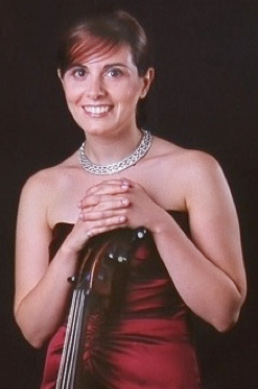
Biana Kovic with cello
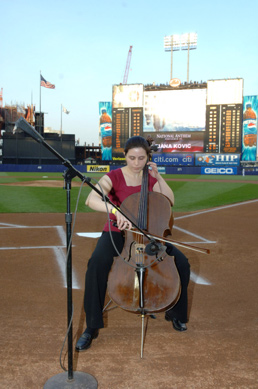
Biana Kovic performs at Shea Stadium.
TOOLS OF THE TRADE
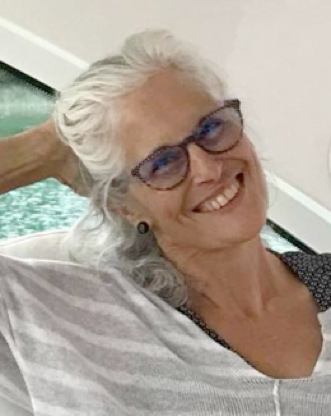
Jill Cliffer Baratta
by Jill Cliffer Baratta
Denise Collins was my watercolor instructor. She claimed to be the first woman ever to become a member of the Salmagundi Club. Denise was a student of Edgar Whitney, a consummate plein air instructor who wrote Complete Guide to Watercolor Painting, copyright 1974. I met several artists on my artistic journey who studied with Edgar and was loaned an audio tape by one, where I was fortunate enough to hear him teaching with the sound of the wind blowing into the microphone.
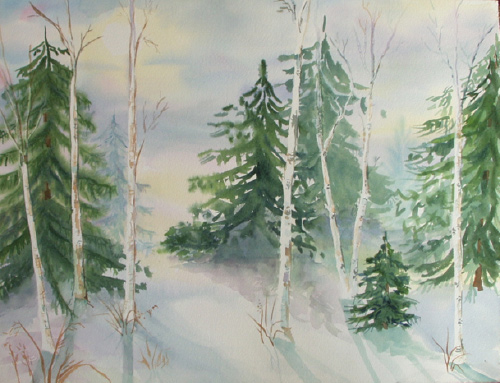
Jill Cliffer Baratta, Pines & Birches, 14 x 20 in., Denise Collins’s style
In his instructions, I heard also Denise’s “voice,” which I heard weekly for around 6 years. While 1974 is long ago, many of Whitney’s concepts are timeless when dealing with water media even though materials, techniques, and aesthetics may have changed. Whitney says, “I feel silly writing about tools. Hundreds of pages…have already advised you; furthermore, the tools used by the best watercolorists have little to do with the qualities in their works. The color and the value chords of each painter, the way (s)he divides space, where [her] interest lies in the gamut between illustration and decoration, would be [her] own even if (s)he painted with a sponge and a shaving brush.” (My gender adjustments).
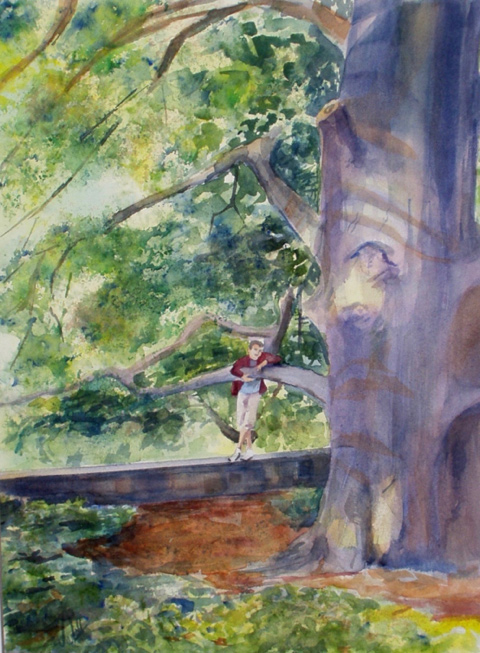
Jill Cliffer Baratta, Large Tree with Youth, 15 x 11 in. Sponge used for foliage
I tend to agree, but you do need to know where to start with watercolor if you have never tried it. Watercolor has a reputation of being “hard to control.” I disagree with that as I believe one can learn to control it. The joy of watercolor is that you learn control by letting it get out of control. Better said, let it be watercolor rather than try to restrict it to being a tight rendering or reporting medium. I like a looser look and enjoy seeing the flowing of pigments in a watercolor work.
While also feeling silly like Whitney, I’ll say there are certain brands of watercolor paints and grades that are better to work with once you get past saving your money on student grade paints. It is good to start with student grade until you decide whether watercolor is a medium for you. It is really easy for a watercolorist to switch to oils or acrylics, but it’s not so easy to transition in the other direction. The skill required to manage watercolor is knowing what level of permanence you are working with and how that affects your ability to make corrections as well as experiencing the amounts of water and pigment required for any given paper and how that works with your composition.

Jill Cliffer Baratta, Haystacks, Watercolor on paper, 11 x 15 in.
My go-to brand is Winsor and Newton. However, there are many other good brands, Sennelier and Holbein among them. If you want to be adventurous, I ran into a young man in Toronto who is making his own handmade watercolors under the name Genzäh (Ryan Zimmerman, genzah.com- expensive but very nice). About permanence or lightfastness, anything that says pthalo is “staining,” otherwise called lightfast and permanent. If you think you might want to wash that hue off of your paper or lift it out find another pigment with a less staining reputation.
You can find “Pigment Information” on websites and in stores. Learn which paints are more or less permanent. Permanence is bad for fixing errors but good for lasting into the future. Less permanent is easier to lift off but may be “fugitive” and fade on the wall if not protected from strong light with positioning and UV safe glass. Get a John Pike palette or comparable. It is best to use tube colors unless you’re packing light for vacation painting or plein air. In which case, use a small cake set or make your own more transportable one.
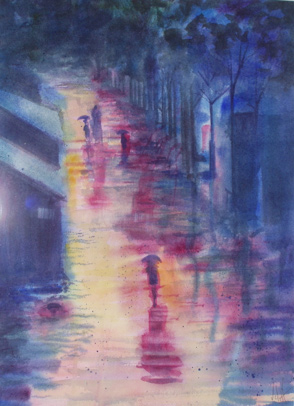
Jill Cliffer Baratta, Paris Street,
Watercolor on paper, 20 x 16 in.
As for paper, Denise brainwashed me not to like Arches watercolor paper. I prefer Lanaquarelle, but I also have used and like Fabriano. The latter have less sizing in them, have a softer feel, and are a more pure white to work on. There are other good ones, but those are ones I have used and loved. As with paints, if you are just starting to experiment with watercolor, save your money and get a student grade watercolor paper pad. They are good enough until you find what you want to do.
Generally, 140 lb. paper is versatile. Use cold pressed paper for fine art watercolor. Hot pressed is more of an illustration medium and much smoother. You can use hot pressed if you prefer it, but I learned on cold pressed and have had little use for hot. If you want to go whole hog, 300 lb. papers are amazing but very hard to break up into smaller sheets. So be warned. The pound value harkens back to what a certain amount of the paper weighs to the paper makers. So for the artist, it just means 90 lb. is lightweight, 140 is heavy enough for most work, and 300 is heavy.
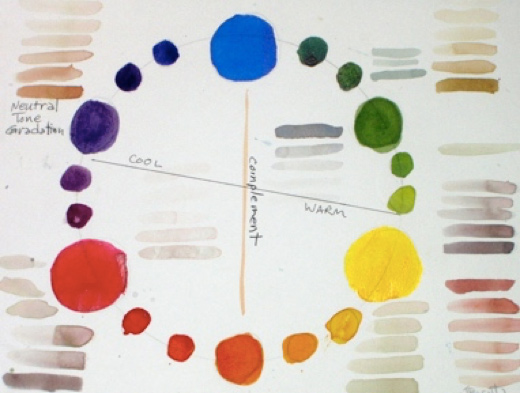
Denise and Edgar before her (never met him) emphasized greatly the design elements of working with watercolor. Edgar recommends a 2-B pencil. It makes a dark enough mark yet is soft enough to erase and not make a groove in the paper. In addition, it is advisable, unless graphite is part of your joy in working, to make very light marks when drawing in your “design. I use the word design because it may be a complex still life, landscape or something partially or totally abstract. In any case, if you want to mark in your composition, work lightly so that the watercolor paint can be the star of the show.
If you want some training exercises, I have devised the following, some of which will be useful and others not at all. I invented them for middle schoolers but found that all beginners benefitted from doing this before attempting to start a watercolor painting.
For this first exercise, if you already know color theory, ignore it. That said, it is still good to learn how your particular palette will mix. Use a Winsor Red, Ultramarine or Cobalt Blue and Aureolin Yellow (or comparable) to create a color wheel to get used to mixing your own watercolor pigments.
This illustration shows primaries mentioned as the largest circles. Mix half of each of two primaries to create secondaries. Then add more and more of the next primary to create two more tertiary colors between those. Next, mix all 3 primaries to create a gray, a brown and a khaki. By dipping your brush lightly in water and wiping it lightly on the side of your water container, make a value gradation from dark to light. This information will stay with you forever.
Next, take a sheet of watercolor paper, 9×12, and divide it in quarters with artists’ tape. In the first quadrant, wet with just water. Then put down a flat wash. Next to that, with a pencil draw very lightly 3 clouds. Wet the negative space around them with a medium brush, and lay in a blue sky. Move onto the 3d quadrant, and wet the whole quadrant except if you want to save a circle to represent the sun or moon. Before it has a chance to dry, lay in some red, blue and yellow to see how this wet into wet works. The colors will migrate.
Use a light touch, and don’t do too much. One stroke of color will suffice. Then let the colors do their thing. Next, go back to the second quadrant. Blue sky will be dry now. With a mixed gray (try mixing blue and brown), make a line at the bottom edge of the cloud. Clean and dry off your brush. With a light dip of water, tease the edge of the gray shadow up until it blends with the white of the cloud. This is a general shading technique that can be generalized for any blended shadow.
Finally, in the fourth quadrant try several techniques at once. Make a cloud by negative painting a gray sky. When the paint is almost dry (when the sheen disappears but it’s still wet), take a “thirsty” brush—wet but dried off pretty well—and pull out the gray sky underneath the cloud. Keep rinsing and drying the brush off until the streaks under the cloud look like rain. Next, use the same technique you used to make the shadows on the clouds in the second quadrant. Make a darker shadow under this rain cloud, but pull the gray all the way to cover it and make it a stormier cloud. Leave most gray at the bottom as a gradated shadow. Finally, fan out your brush, dip it into the gray, and lightly glaze the streaks of rain over the pulled-out area under the cloud. Now you have learned a wash, negative painting, shading, wet-in-wet, and glazing, all in one quick exercise that will inform your foray into watercolor.
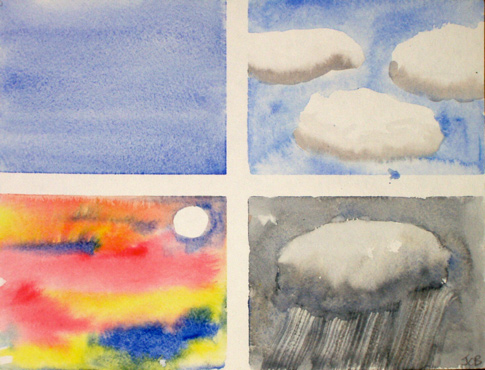
If you want to try one more exercise, divide the paper again, draw 4 pieces of fruit, and experiment with making four backgrounds and four fruit objects on one sheet. This also teaches you to move from one area to another to let one dry before laying in a second color. It instructs the patience it takes to sometimes work on more than one painting at a time so that you don’t ruin what you are doing with colors migrating when you don’t want them to. I have said before that the running and flow is what watercolor is all about, so let it happen. Make sure it’s when you want them to run and flow.
Here is one middle-schooler’s fruit views exercise, 6 sections on 11 x 14 in. paper.
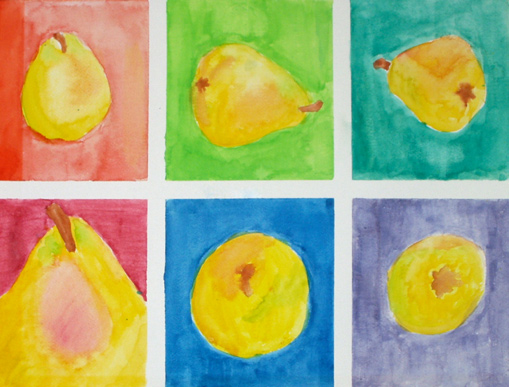
These are beginning watercolor exercises to learn some of the basic ways to control it. I recommend the following books (in addition to perusing John Singer Sargent, Winslow Homer, Helen Allingham, Moira Clinch, my friend Chizuru Kaplan, our own Natalia Koren Kropf, and the list goes on.)
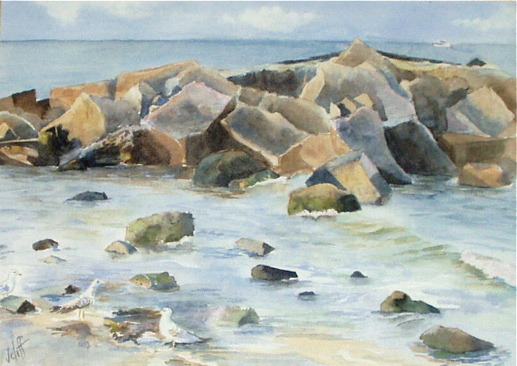
Jill Cliffer Baratta, Cape May Point, Watercolor on paper, 17 x 23 in.
The Watercolor Artist’s Handbook, edited by Sally Harper, Barrons Educational Series, Oceana Books, London, 2003
Complete Guide to Watercolor Painting, Edgar A. Whitney, Dover Publications, New York, 1974
For more examples of Jill’s watercolors, plus collage and prints, see www.jcbarattasart.com
HAPPY NEW YEAR!
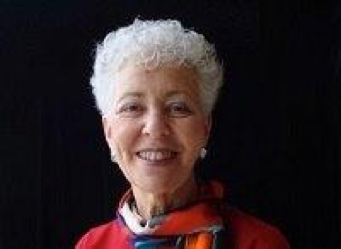
Carol Z. Brody
Carol Z. Brody NWS (National Watercolor Society), TWSA (The Watercolor Society of America) is an award-winning watercolorist known for her beautiful Party Papers and Ribbons series. This series has been exhibited widely in international juried shows around the world and has appeared in watercolor books and magazines. Carol began working in watercolor in 1975 after seeing the intriguing paintings of Courtney Milnes, a Staten Island, NY, watercolorist who became her teacher. Several years later, Carol studied at Parsons School of Design with Barbara Nechis, who introduced her to the negative style of painting which is apparent in most of her work.
Carol’s prior work in acrylics and collage led to the evolution of her current body of work in which she creates the look of collage, confetti and ribbons in transparent watercolor. She employs textural features and patterns along with her lyrical colors to create a joyous, party-like feeling which delights the viewer’s senses.
Carol joined NAWA in about 2000 and was the Florida chapter historian for about five years. She has actively participated in the chapter’s exhibitions and events during the years of her membership. She currently lives in Wellington, FL, where she teaches classes. She also gives workshops, demos, and juries shows around the country. In Carol’s words, “The camaraderie of the women in our group has meant a great deal to me over the years.”
Carol is soon to be featured in the Missouri Watercolor Society International Exhibition in Barcalona, Spain.
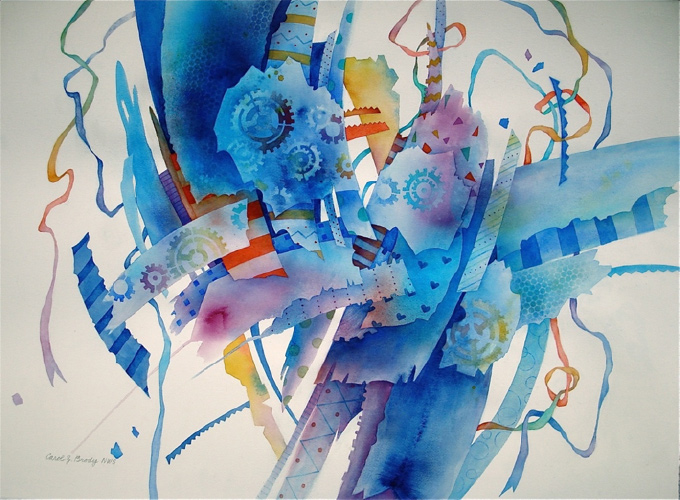
Carol Brody, Party Papers, Ribbons and Confetti VI, Watercolor on paper
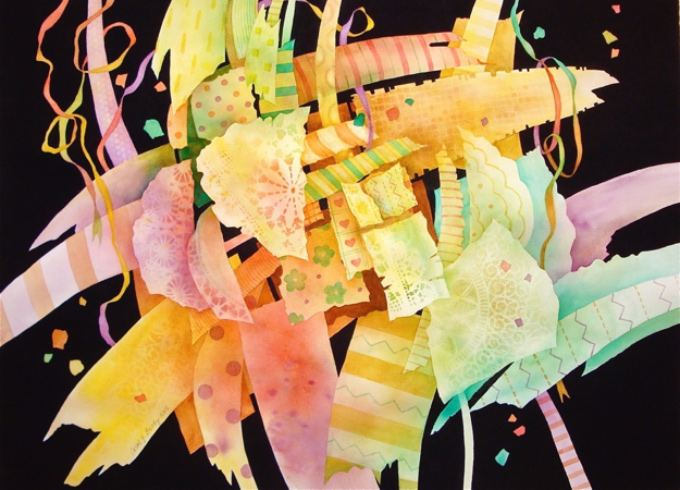
Carol Brody, Party Papers, Ribbon and Confetti, IV, Watercolor on paper
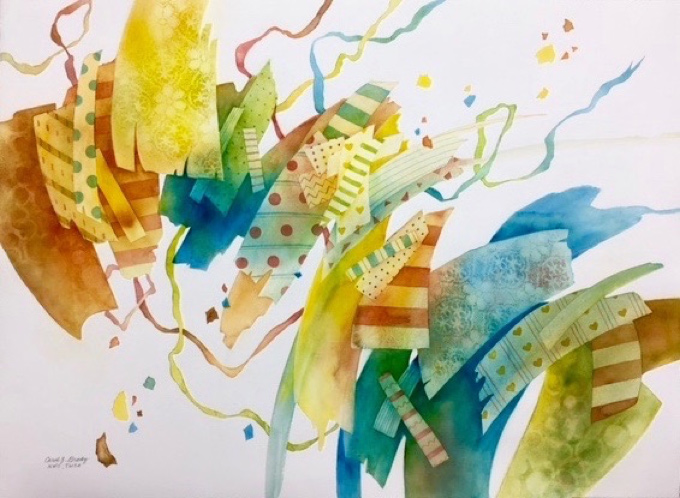
Carol Brody, Party Papers, Ribbon and Confetti VII, Watercolor on paper
CHAPTER CHAT
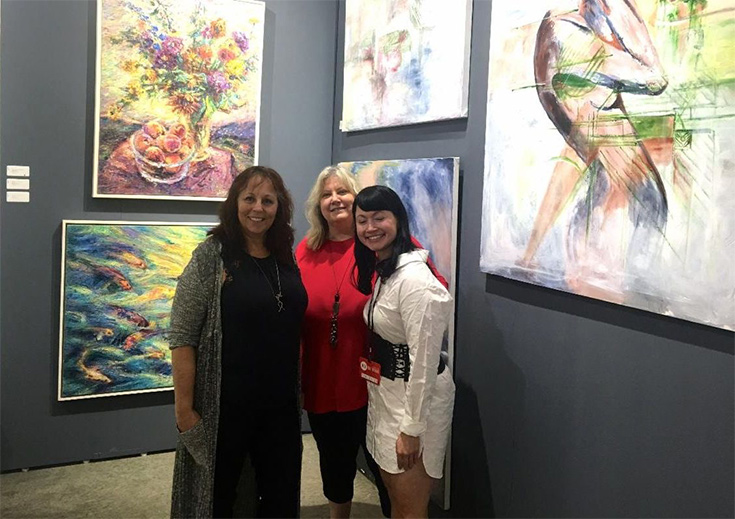
Roberta Millman-Ide (FL), Kate Kennedy (SC), Jean Costello (MA)
FLORIDA CHAPTER
by Roberta Millman-Ide, President
Happy New Year and welcome to 2020! Our MS CONCEPTIONS reception was January 9, beginning with an artist talk and followed by the reception with awards. Pat Zalisko and Muffy Clark Gill have done an excellent job coordinating this event with local media.
Workshops are underway where members can donate a couple hours of their time to share their knowledge with their sister members. This can be a wonderful way to learn something new as well as to get some practice with teaching skills in a friendly environment.
On our schedule is the Strathmore presentation by Strathmore representative Nancy Spielman at my home studio on January 21. On February 12, Shirley Camhi Goldblatt will hold a workshop, “Create New Work from Old,” at my studio, utilizing old paintings or drawings that don’t work. They can be cut up for collage, used to create brand new work or placed on existing work. On March 4, Sara Zigdon’s workshop, “Inspired by Andy Warhol…with a Twist” will involve embroidery on Jute fabric sack at her studio.
Pat Zalisko will act as coordinator for a professional development Workshop with venue and date TBD. The workshop will consist of a moderator and several professionals from various disciplines, such as a gallerist, a museum curator, an art center director or director of exhibitions, an art marketing specialist, an art coach who is skilled in writing or coaching artists in critiquing their own work and writing about it, and perhaps others, such as an arts educator and/or forensic art investigator.
Our Annual Luncheon took place Monday, December 9 at Benvenuto in Boynton Beach. Thanks are due to our wonderful guest speakers Victoria Jimenez, a NAWAFL member, and Anabel Rub Peicher, who gave a very interesting presentation on contemporary women artists of Columbia.
SOUTH CAROLINA CHAPTER
by Kate Kennedy, President
Currently, we have a featured NAWA artist at the Savannah Art Walk every month through August 2020. We have a group exhibit scheduled for September 2020 at Art League of Hilton Head Gallery. An exhibit at the Coastal Discovery Museum on Hilton Head Island is scheduled January 2021
Education Events:
We are planning a luncheon and panel discussion on Social Media Strategy in February 2020. Four 5-minute presentations will be given from subject matter experts on their secrets, successes and strategy.
A presentation on Gullah Art at Penn Center, St Helena Island, SC by our Gullah artist members is in the planning stages.
In the works:
Brookgreen Gardens, Murrells Inlet, SC — Brookgreen Gardens is the largest sculpture collection in the US with three galleries. It was founded by Anna Hyatt Huntington and her husband Archer. Anna was also a founding member of NAWA. We are meeting in January to work out the details for both a National NAWA exhibit and a SC Chapter exhibit in their galleries. We will also use the extensive gardens for Plein Air events and group meetings.
I was in Florida last week to open a show and had the pleasure of meeting with the Florida NAWA Board President, Roberta Millikan-Ide, and Massachusetts Board President, Jennifer Jean Costello, who was exhibiting at Red Dot Miami during Art Basel Week. We have come up with some great ideas for joint ventures. The Marker 23 Gallery that I am exhibiting at currently is going to host a NAWA FL and SC joint Exhibit. The Gallery currently exhibits 70 artists, comprises two floors, and is located on the waterfront, surrounded by working artist studios, restaurants and a marina. Roberta will take the lead as she lives only an hour from the gallery.
MASSACHUSETTS
by Jennifer Jean Costello, President
Best year for us all! Excited.
As practicing artists, we live each day to the fullest and take the time to see. Thank you to the ‘Old’ and hello to the ‘New’ Year.
It has been a busy few months, opening and closing successful shows including our non-juried exhibition HUE-MAN-IZE at the John Joseph Moakley United States Courthouse, home of Ellsworth Kelly’s The Boston Panels. From January 18 to April 4, 2020, SHE will be on display at The Gallery at Atlantic Wharf, Seaport, a space designed by Höweler + Yoon Architecture with a highly visible “cloud” ceiling and monumental stairs—two architectural elements that act as iconic markers for the gallery space. Opening February 5, 2020 at the Boston Magazine 2019 “Best of Boston” Fountain Street Gallery, will be Lust After, juried by Fountain Street founder and director Marie Craig. Also, in early 2020 there will be at Canvas Fine Art, Boston, Floating Dreams March 4–31, Mirror Image at the Marblehead Arts Association March 14–April 26, 2020, and a Spring Soiree at District Hall, Boston.
Our members are on fire! Please check out our revamped website https://nawama.org/ to see members’ images and links to their websites for amazing updates. We are on a creative journey together, so stay tuned for more sail and enchantment in our personal and artistic endeavors.
Thank you again, Kim, for being our second chapter president, colleague, and for continuing to strengthen our chapter’s creative family. We ‘universal communicators’ are documenting, creating, and possibly repeating chapters of human history. Let’s float together in 2020 in ease and love.
NAWA READS
By Nancy Vineburgh
NINTH STREET WOMEN
Lee Krasner, Elaine de Kooning, Grace Hartigan, Joan Mitchell, and Helen Frankenthaler: Five Painters and the Movement that Changed Modern Art
Mary Gabriel
Little, Brown and Company
2018
Ninth Street Women chronicles the lives of five women artists who emerged and were subsequently submerged in the Abstract Expressionist movement of post WW II America. Hampered by complex and oftentimes tumultuous relationships, Lee Krasner, Elaine de Kooning, Grace Hartigan, Joan Mitchell and Helen Frankenthaler struggled for artistic self-expression and recognition in an art world dominated by men. Ultimately, they prevailed as accomplished artists and as independent women who took their rightful place in the history of modern art.
The title of the book derives from a 1951 exhibit, The Ninth Street Show, a grassroots endeavor to bring attention to a group of painters who had experienced extreme poverty during the Depression era and an artistic nihilism in the aftermath of WWII. As the author states, these artists “stripped their work of all life except their own internal meanderings because they existed in a world destroyed by war, dehumanized by the death camps, and denied a future by the atomic bomb. Under those circumstances, what else could they paint with any degree of honesty?”
The Ninth Street Show featured 72 artists whose names were largely unknown. Among them the five women for whom this book is written and the iconic de Kooning, Pollock, Motherwell, Resnick and Rauschenberg. Important opinion makers — art critics, uptown gallery dealers and museum directors — came face to face with what would be a monumental art movement and one that shifted the center of the art world from Paris to New York. The revelry that ensued, involving heavy alcohol and tobacco use, dancing into all hours of the morning, an environment of free love and day time painting was supported by all the aforementioned. This state of affairs persisted well after the show’s success and influenced the lives of these five women.
Lee Krasner and Elaine de Kooning were the two grand dames of the first generation of the Abstract Expressionist era. Lee was married to Jackson Pollack and Elaine to Willem de Kooning. Both women sublimated their pursuit of painting to showcase their husband’s work. Both marriages were marred by their spouses’ drinking problems, their womanizing, and their reckless lifestyle. Pollock died at 44 years old in East Hampton, the result of drinking and driving at high speed. Lee took charge of his estate. With great business acumen, she asked and received unprecedented prices for his work, which helped escalate the value of modern art. In 1984 Lee died several months before the fruition of her lifetime dream, a retrospective of her work at the Museum of Modern Art. Before her death, she set up the Pollack-Krasner Foundation to help struggling artists.
In addition to painting, Elaine wrote for ArtNews Magazine, marrying de Kooning in 1943. She was deeply involved in promoting his art. A highlight of her career was being asked to paint a portrait of John F. Kennedy who was assassinated shortly before she finished. Elaine and Bill both struggled with alcoholism, which led to their estrangement and Bill’s relationship with a younger woman. At the end of their lives, they reunited. Elaine died in 1989 from lung cancer; Bill suffered from dementia and died in 1997.
Of the three second generation abstract expressionist painters, Helen Frankenthal, Joan Mitchell and Grace Hartigan, Grace achieved the greatest success. By 1954, her sales totaled fifty-five hundred dollars, just short of de Kooning’s seven thousand during that same period.
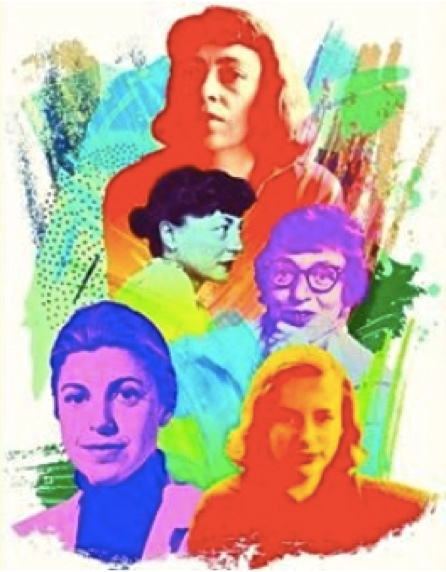 Joan Mitchell, who was influenced by de Kooning, spent much of her career in France and was highly regarded both in Europe and America. Like Elaine, she died of lung cancer in 1992. Her legacy includes the Whitney Museum retrospective, ‘Joan Mitchell Pastels’ and The Joan Mitchell Foundation to aid and assist the visual arts.
Joan Mitchell, who was influenced by de Kooning, spent much of her career in France and was highly regarded both in Europe and America. Like Elaine, she died of lung cancer in 1992. Her legacy includes the Whitney Museum retrospective, ‘Joan Mitchell Pastels’ and The Joan Mitchell Foundation to aid and assist the visual arts.
Jackson Pollock’s work inspired Helen, who had been romantically involved with the influential art critic, Clement Greenberg. She ultimately married and divorced fellow artist Robert Motherwell, marrying yet again. She established the New York-based Helen Frankenthaler Foundation, dedicated to promoting greater public interest in and understanding of the visual arts.
Ninth Street Women is a serious read and a book that can be enjoyed a chapter at a time. Its strength is its historical focus, which illuminates many fascinating aspects of and influences on the abstract expressionist movement, a game changing force in American art. The writer also places each of the featured artists in the context of the women’s movement and the challenges of being a female artist. A great line in the book, which sums up the chutzpah and tenacity each woman embodied, is when art historian Irving Sandler once asked Grace, “Has any male artist ever told you you paint as well as a man? She replied, “Not twice……”
LETTERS
By Mimi Herrera-Pease
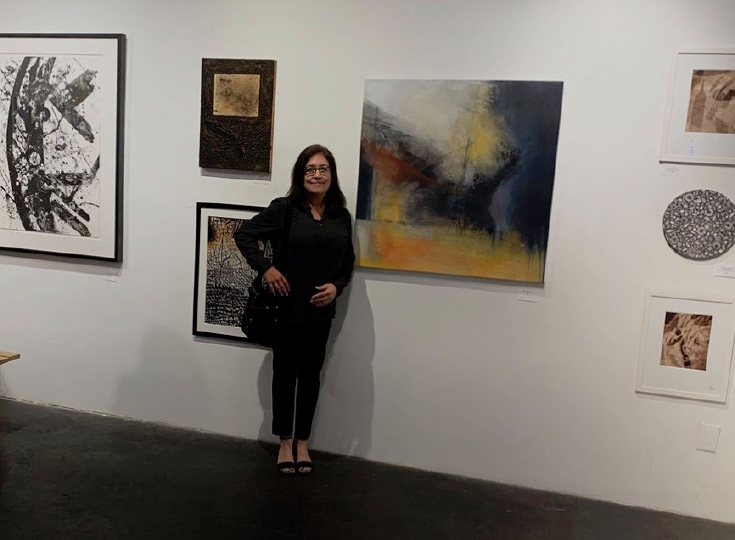
Dear NAWA Members:
As Sandra Bertrand and I add the final submission to the January newsletter, I begin to reflect upon the rewarding experience of co-creating and working on the quarterly publication. This issue marks the 3rd year of sharing member news, artwork, and exhibitions of accomplished women artists. At this juncture, due to family commitments and the need to spend more time in the studio, I have decided to step down from my position.
I will miss curating the e-newsletter and adding artwork to Sandra’s beautifully written articles. It has truly been an honor working with her. I would like to thank webmaster, Elizabeth Cline, for the wonderful job of placing our articles on the NAWA website. She does amazing work. I would also like to thank my husband, David, for proofreading each issue prior to its release.
Gratefully, new member and talented sculptor, Sarah Katz, will step in as co-editor. Please email her at skatz181@me.com with current and upcoming solo and two person exhibitions, publications, and accomplishments that you’d like to share with the NAWA community.
Saying goodbye is difficult, but I will not be ghosting completely. I have offered to take on the position as administrator of the NAWA Instagram handle. Stay tuned for more information on that. Meanwhile, keep creating and making phenomenal art!
Sincerely,
Mimi Herrera-Pease
Outgoing Co-editor, NAWA NOW
CURRENT & UPCOMING NAWA EXHIBITIONS
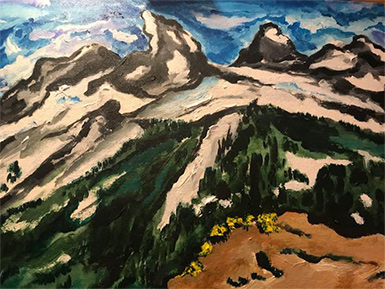
Artwork by Sandra Bertrand
COLD II
NAWA Gallery
315 West 39th Street, Suite 508
New York, NY 10018
January 8 – January 30, 2020
Reception: January 9, 5:00-7:00pm
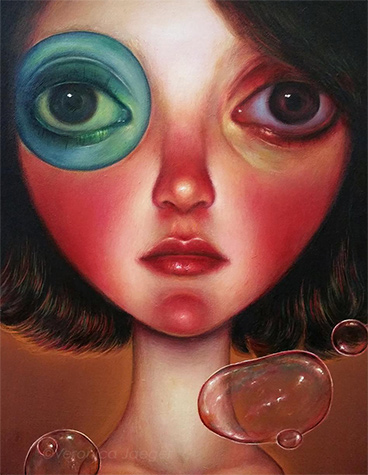
Artwork by Veronica Jaeger
SMALL WORKS WINTER
NAWA Gallery
315 West 39th Street, Suite 508
New York, NY 10018
February 5 – February 26, 2020
Reception: February 13, 5:00 – 7:00 pm
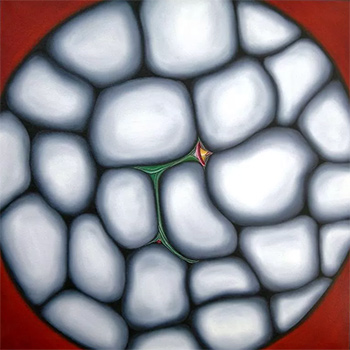
Artwork by Pamela Flynn
Pamela Flynn, Ginka Miltova, Makiko Tamori
NAWA GALLERY
315 West 39th Street, Suite 508
New York, NY 10018
March 4 – March 26, 2020
Reception: March, 2020
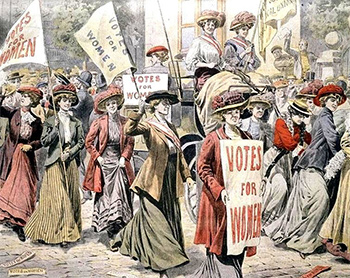
Grand Visions: We are Here
Grand Central Library, NYPL
145 East 46th Street, NYC
March 1– March 29, 2020
Reception: March 14, 2:00 – 4:00 pm
Book presentation by Penny Coleman, author of The Vote: Women’s Fierce Fight
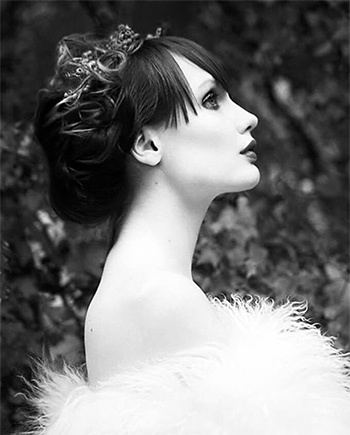
Artwork by Karla Pivonski
Photography
NAWA Gallery
315 West 39th Street, Suite 508
NYC 10018

Artwork by Mimi Herrera-Pease
Texture and Surface
OIL AND ACRYLIC
NAWA Gallery
315 West 39th Street, Suite 508
NYC 10018
EXHIBITS ON YOUR RADAR
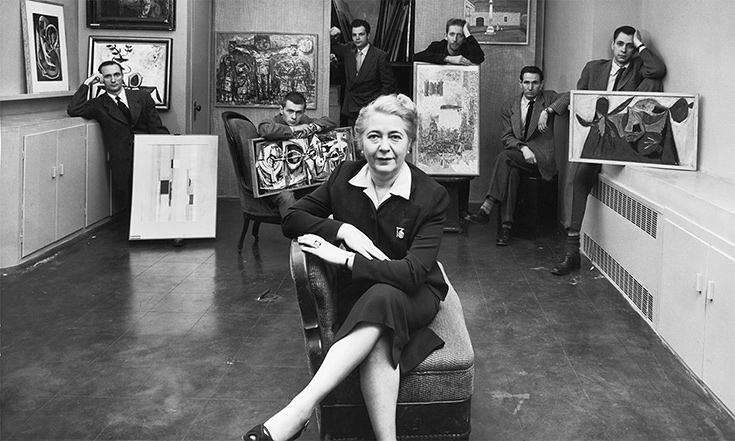
Edith Halpert at the Downtown Gallery surrounded by some of her artists, Photograph for Life magazine, 1952. Photograph © Estate of Louise Faurer
Edith Halpert and the Rise of American Art
The Jewish Museum, NYC
October 18, 2019 – February 9, 2020
When drawing attention to exhibits, it’s generally the artist who’s the star of the show. But sometimes it can be the woman behind the scenes who makes it all happen. From October 18 to February 9, 2020, The Jewish Museum in NYC is featuring Edith Halpert and the Rise of American Art. Imagine that one woman could do so much to aid in immortalizing the careers of American modernists from Stuart Davis, Jacob Lawrence and Georgia O’Keeffe to many others.
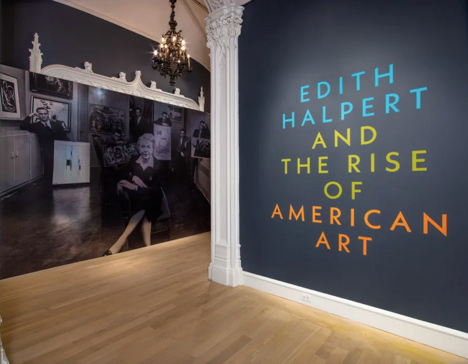
Installation view of Edith Halpert and the Rise of American Art at The Jewish Museum, NYC.
Edith Halpert (1900-1970) opened her now legendary space, the Downtown Gallery, in 1926. It was the first commercial art exhibit space in NYC’s Greenwich Village and Halpert was the first significant gallerist to pave the wave for other women leaders in the art field. As an outsider—a Russian immigrant, a woman, and a Jew—for over 40 years, she was a leading authority of America’s artistic landscape and a name to remember.
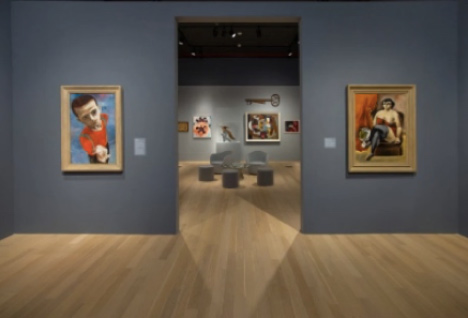
Installation view of Edith Halpert and the Rise of American Art at The Jewish Museum, NYC.
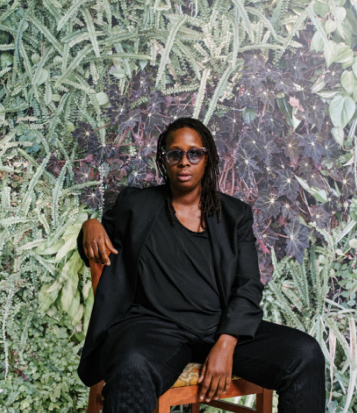 Mickalene Thomas: Better Nights
Mickalene Thomas: Better Nights
The Bass Miami Beach Contemporary Museum
December 1 – September 27, 2020
Inspired by the local New Jersey play ‘Put a Little Sugar in my Bowl’ organized and performed by the artists’ mother, friends, and family as well as the parties hosted by the artist’s mother in the late 1970s, Mickalene Thomas: Better Nights is an installation that will transform the Bass Miami Beach Contemporary Art Museum (from December 1, 2019 to September 27, 2020) into an immersive art experience for the duration of the exhibition.
The Bass installation embodies an apartment environment, conceptually reconstructed according to the domestic aesthetic of the period, including the artist’s signature textiles. It incorporates both work by the artist and a curated selection by Thomas featuring work by emerging and prominent artists of color.
Born in 1971 in Camden, NJ, she is an artist and filmmaker whose paintings continue to combine art-historical, political and pop-cultural references. She challenges the common cultural definitions of women and beauty.
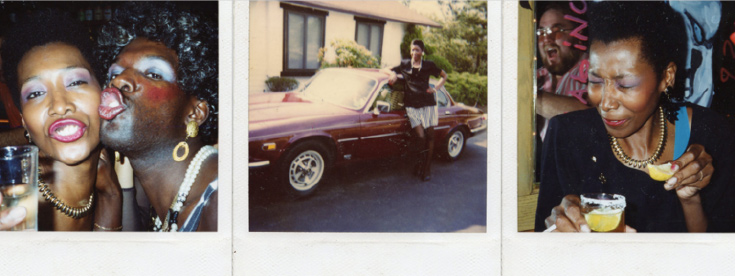
Mickalene Thomas’s mother, friends, and family, Polaroids.
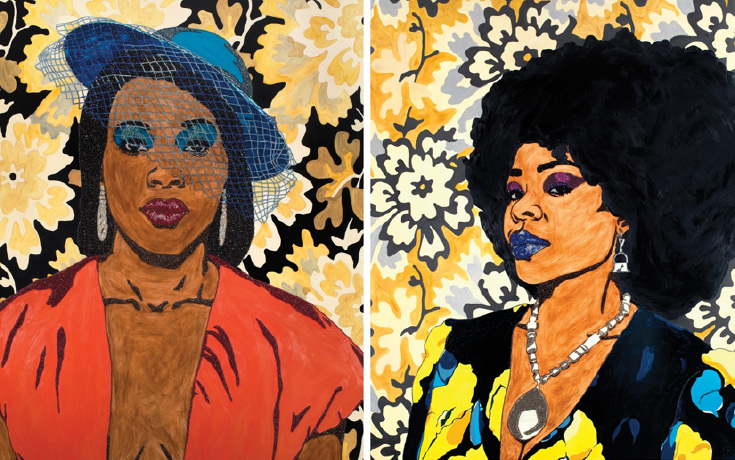
Mickalene Thomas, Din, une tres belle negresse, #1, 2011, Din, une tres belle negresse, #1, 2012
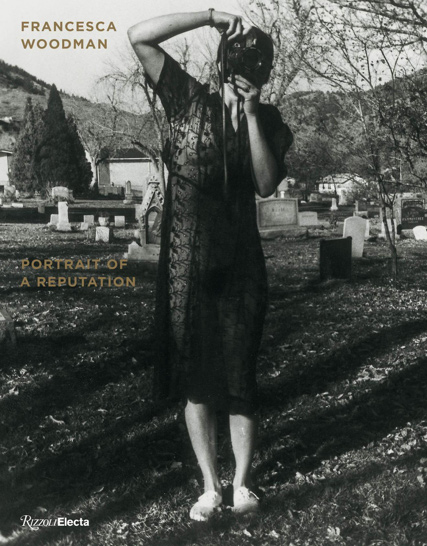
Exhibition catalog, Francesca Woodman: Portrait of a Reputation
Francesca Woodman: Portrait of a Reputation
Museum of Contemporary Art Denver (MCAD)
September 20, 2019 – April 5, 2020
It’s an unfortunate truth that suicide, the abrupt and tragic end of a life, can sometimes color the way we think of an artist. Photographer Diane Arbus, as much of an aberrant genius as she was, is a perfect example of this phenomenon. In Francesca Woodman’s case, the Museum of Contemporary Art in Denver, CO has chosen, thanks to curator Nora Burnett Abrams, to filter out this artist’s death at 22 as a focal point in experiencing her work.
George Lange, a pal from her student days at the Rhode Island School of Design, had in his possession for decades her photographs, letters, and contact sheets. When his collection finally came to light three years ago, Ms. Abrams made the decision to feature the work, including 50 photos, artifacts and an additional 45 by Lange, capturing her time at RISD. Self-made images with gothic overtones, nude studies in nature and mirror images show a hard-working young woman engaged in her craft, rather than a fledgling but tortured artist. (SB)
(Francisca Woodman: Portrait of a Reputation continues at the Museum of Contemporary Art, Denver through April 5, 2020.)
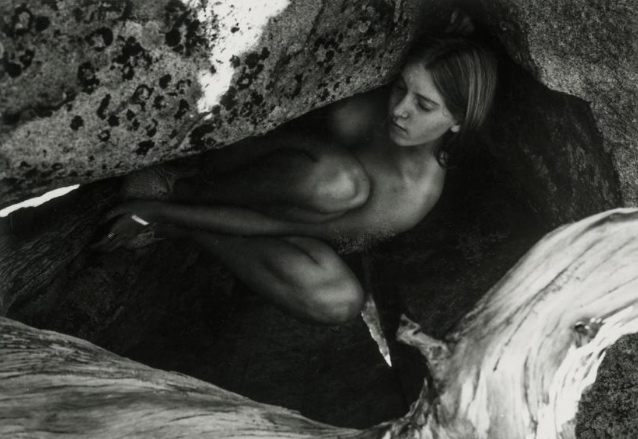
Francesca Woodman, Untitled photograph, circa 1975-1978, Gelatin Silver print.
George Lange Collection © Estate of Francesca Woodman/Charles Woodman/Artists Rights Society (ARS), New York
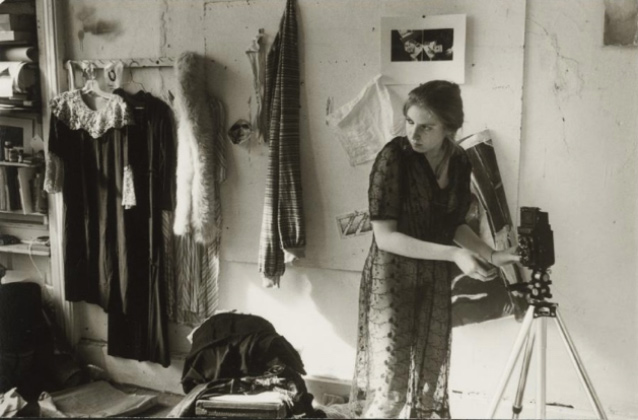
George Lange, Untitled Photograph, circa 1975-1978. Gelatin silver print. George
Lange Collection. Courtesy of the artist.
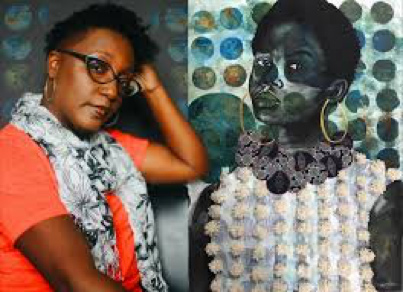 Delita Martin: Calling Down the Spirits
Delita Martin: Calling Down the Spirits
National Museum of Women in the ARTS (NMWA)
January 17 – April 19, 2020
Delita Martin (b. 1972, Conroe, Texas) creates large-scale prints onto which she draws, sews, collages, and paints. Martin claims space for her subjects, particularly black women, creating a powerful presence that simultaneously highlights the historical absence of black bodies in Western art.
Delita conveys these connections of African tradition through symbols such as circles, a shape representative of the moon and symbolic of the female, and birds, which represent the human spirit. Masks, inspired by the Sowei and Iife masks of West Africa, appear in many of Martin’s works, signifying transition between this world and the spirit world. Her use of color is also symbolic, particularly blue, which she associates with spirituality. (Delita’s complex and arresting works make her a strong contender to carry on the artistic mission of artists such as Betye Saar, featured in our October 2019 issue.)
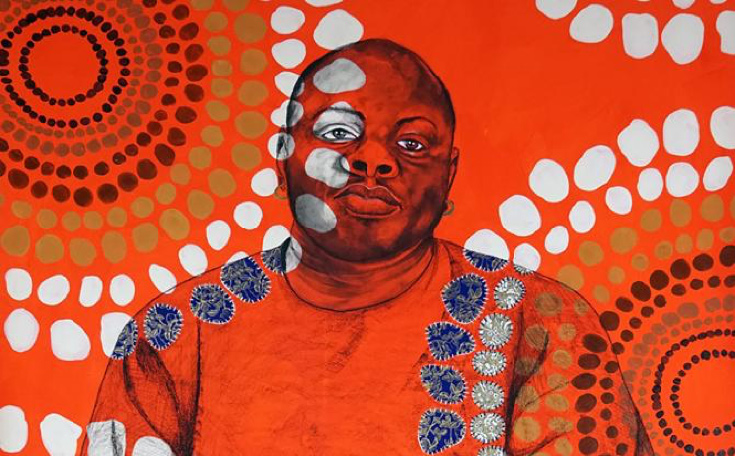
Delita Martin, Believing in Kings (detail), 2018; Courtesy of the artist and Galerie Myrtis: Photo by Joshua Asante
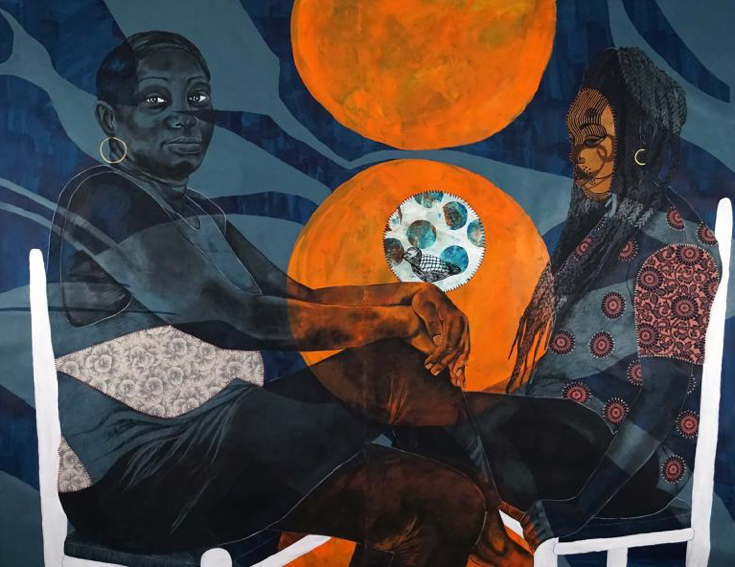
Delita Martin, The Moon and the Little Bird, acrylic, charcoal, gelatin printing, decorative
papers, hand-stitching, and liquid gold leaf, 79 x 102 in., Courtesy of the artist and Galerie Myrtis: Photo by Joshua Asante
EVENTS
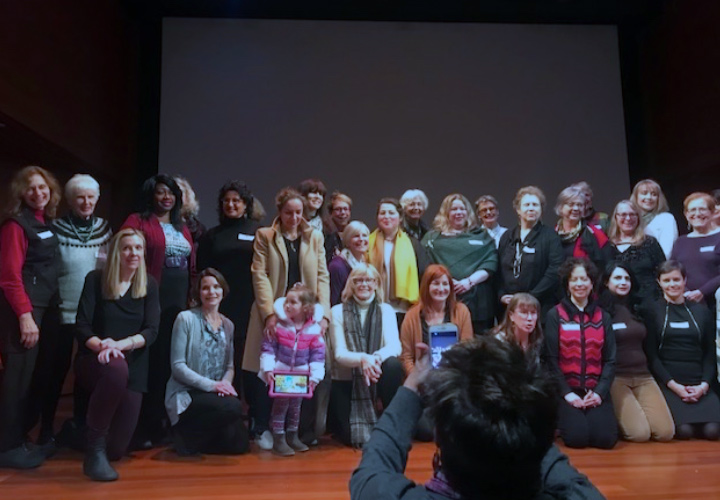
New Members’ Induction Ceremony, Rubin Museum of Art, NYC, November 14, 2019
2019 General Membership Meeting and New Members’ Induction Ceremony
On Thursday, November 14, 2019 almost 100 new members were inducted into NAWA at the beautiful Rubin Museum of Art in New York City.
For many of us this is the most exciting and inspirational event of the year. The electricity of expectation among the attendees—the support and sharing that each artist can look forward to with her membership, was palpable in the auditorium. Welcome speeches were heard from Natalia Koren Kropf, President and Susan G.Hammond, Executive Director, as well as the introduction of our new Executive Director, Biana Kovic. Brief speeches were also given by Committee Chairs: Carol A. O’Neill, Awards; Anita Pearl, Exhibitions; Susan B. Phillips, NAWA Gallery; Sandra Bertrand, Newsletter; and Susan G. Hammond, Membership. A Power Point presentation gave participants an opportunity to see samples of the inductees’ artworks.
Later in the afternoon, a Reception at the NAWA Gallery provided the chance to see up close members’ artworks and meet many of the new members across the country.
The New Members included 48 in Painting; 23 in Works on Paper; 10 in Mixed Media/Collage; 2 in Fiber Arts; 7 in Photography; and 7 in Sculpture for a total of 97 new members! Their addition to our national membership will provide all of us with a renewal of artistic passion and purpose now and in the decades to come.
Congratulations to all!
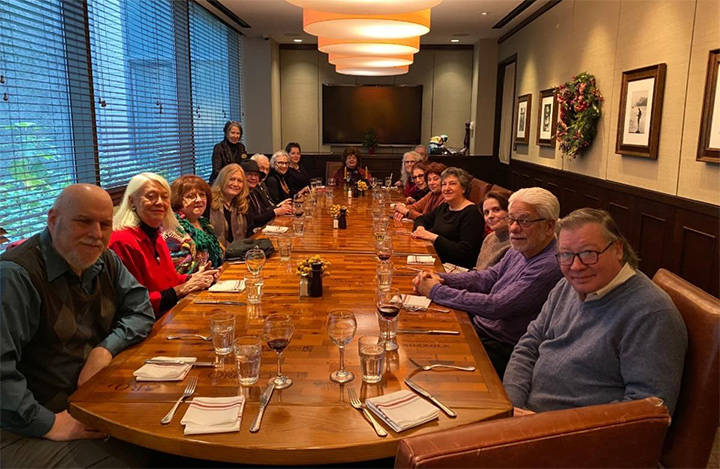
Susan G. Hammond’s Retirement Party
Executive Director Susan Hammond’s retirement party was held at Café Nonna, NYC, on December 16, 2019. It was a bittersweet occasion for everyone—board members and NAWA member friends alike—but the love, laughter and wine flowed through the afternoon, and we knew that our beloved Susan was not saying goodbye to NAWA, but simply being elevated as NAWA Emerita on our hearts and minds.
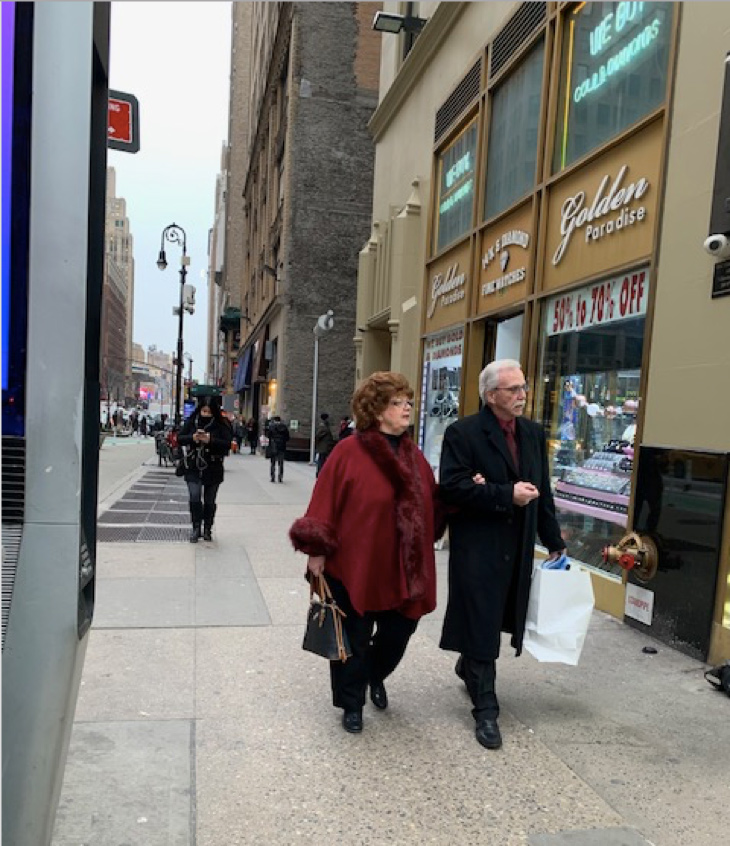
Susan Hammond and her husband Garret, Fresh Beginnings, photo: Penny Dell
CURRENT/UPCOMING MEMBER SOLO AND TWO-PERSON EXHIBITS
Anna Walinska
Return to Riverside
The Master Gallery
310 Riverside Drive, NYC
October 24, 2019 – January 24, 2020
Reception: October 24, 7:00 – 8:30pm
PUBLICATIONS
Robin Antar
Square Mile
The Best Sculptures in the World
December 2, 2019
www.squaremile.com
Gale Madeira
International Magazine
December/January, 2019
www.internationalmagazine
NAWA, Florida Chapter
Naples Daily News
January 4, 2020
Florida Chapter, National Association of Women Artists
www.naplesnews.com
Celia Rabinovitch (Author)
Duchamp’s Pipe: A Chess Romance – Marcel Duchamp & George Koltanowski
www.penguinrandomhouse.com
www.amazon.com
A WORD FROM YOUR CO-EDITORS
Ringing in the New Year doesn’t have to be a time of high anxiety. Admittedly, it can be a little auspicious, but that can be good. For women in all fields of endeavor, 2020 is a year to celebrate. On August 18, 1920 the 19th Amendment was ratified to give women the vote. In Elizabeth Cady Stanton’s words, “Inasmuch, then, as woman shares equally the joys and sorrows of time and eternity, is it not the height of presumption in man to propose to represent her at the ballot box?”
Well, thanks to Ms. Stanton and others like her, we enjoy the privilege of representing ourselves just fine. Whether in exhibits, arts organizations, public forums or in the privacy of our own studios, we are exercising our right to let our own best creative selves be heard. Sometimes we must push a little harder, raise our voices a little louder, but we have proven we can do it. There’s still much to be done, but we’re up to the task.
FOR OUR APRIL ISSUE:
Send us news about your solo and two-person exhibits or statewide biennial or triennial shows that you feel we should publish. Remember each issue features a Shout Out section. So we are interested in hearing anything you feel should be on our radar.
And don’t forget to celebrate yourselves and one another! We deserve it!
Sandra Bertrand: mailto:sbertrand1@earthlink.net
Sarah Katz: mailto:skatz181@me.com





 RHONDA URDANG
RHONDA URDANG